1. Introduction
Radio astronomy stands at the threshold of a transformative era, marked by the advent of large sky surveys carried out with instruments such as the Square Kilometre Array (SKA) (Dewdney et al., Reference Dewdney2016) and its precursor telescopes. As the field enters this golden age, the immense volumes of observational data generated pose unprecedented challenges and opportunities. For example, the Evolutionary Map of the Universe (EMU) (Norris et al., Reference Norris2011) of the Australian SKA Pathfinder (ASKAP, Johnston et al., Reference Johnston2008; Hotan et al., Reference Hotan2021) started in 2022 to survey
![]() $\sim$
75% of the sky at 940 MHz with an angular resolution of
$\sim$
75% of the sky at 940 MHz with an angular resolution of
![]() $\sim$
15′′ and a noise rms of
$\sim$
15′′ and a noise rms of
![]() $\sim$
15
$\sim$
15
![]() $\mu$
Jy/beam. The EMU source cataloguing process will require an unprecedented degree of automation and knowledge extraction, as the expected number of detectable sources is
$\mu$
Jy/beam. The EMU source cataloguing process will require an unprecedented degree of automation and knowledge extraction, as the expected number of detectable sources is
![]() $\sim$
50 millions. So will be for other precursors and future SKA observations. The sheer scale and complexity of these datasets demand innovative approaches to shorten the time needed to deliver scientific results or groundbreaking discoveries.
$\sim$
50 millions. So will be for other precursors and future SKA observations. The sheer scale and complexity of these datasets demand innovative approaches to shorten the time needed to deliver scientific results or groundbreaking discoveries.
In this context, machine learning (ML) emerges as a powerful tool for unlocking the full potential of radio astronomy data, offering solutions to complex tasks that are often beyond the reach of conventional methods in multiple areas, including source extraction, classification (e.g. morphological or astrophysical type) and discovery of anomalous/unexpected objects. Most existing contributions focused on galaxy morphology classification for extragalactic science cases employing either supervised learning (SL), e.g. with convolutional neural networks (CNNs) (Aniyan & Thorat Reference Aniyan and Thorat2017; Lukic et al., Reference Lukic2018; Wu et al., Reference Wu2019; Lao et al., Reference Lao2023) or Vision Transformers (ViTs) (Gupta et al., Reference Gupta2024), weakly-supervised learning (Gupta et al., Reference Gupta2023), semi-supervised learning (Slijepcevic et al., Reference Slijepcevic2022), or unsupervised learning, e.g. Self-Organizing Maps (SOMs) (Galvin et al., Reference Galvin2020; Mostert et al., Reference Mostert2021; Gupta et al., Reference Gupta2022) or t-distributed stochastic neighbour embedding (Pennock et al., Reference Pennock2022).
Despite substantial progress, the full potential of supervised approaches often remains untapped due to the scarcity of large and high-quality annotated radio image datasets, crucial for training very deep models. The human effort required to produce them is in fact unsustainable. Citizen science projects, launched within different precursor surveys on the Zooniverse platformFootnote a , Footnote b and building on the previous Radio Galaxy Zoo project (Banfield et al., Reference Banfield2015), will partially alleviate this need, at the cost of potentially introducing errors and biases in the cumulative dataset. As a result, existing labelled radio datasets are typically very limited in size, class-unbalanced, and adopt a diverse or ambiguous labelling schema, usually depending on the particular domain of application. Several applications produced so far for either radio source classification or source detection scopes, have therefore resorted to fine-tune models that were previously pre-trained on large annotated collections of non-astronomical data, such as the ImageNet (Deng et al., Reference Deng2009) or COCO (Tsung-Yi et al., Reference Tsung-Yi2014) datasets, that may not well capture all distinctive features of radio observations. On the other hand, completely unsupervised approaches are not very effective when directly dealing with highly dimensional image data, typically requiring previous feature extraction and dimensionality reduction steps to be applied. Currently, employed methods based on SOMs typically enforce an apriori discrete static data organization that do not well support extension to new tasks. These limitations necessitate exploring alternative methodologies.
Representation learning (Bengio & Anal Reference Bengio and Anal2013), and in particular self-supervised learning (SSL) (Liu et al., Reference Liu2023), has recently emerged as a promising avenue to address these issues, by directly learning (pretext task), without any supervision, a lower-dimensionality representation (i.e. the latent space) from large samples of unlabelled data. The resulting model and data representation can then be used for data inspection and generalized for various applications (downstream tasks), e.g. classification, object detection, etc, if a small subset of labelled data is available. Previous works in the radio domain are based on convolutional autoencoders (CAE) generative methods, which learns a latent space by minimizing a loss between input data and data reconstructed through an encoder-decoder network. For example, Ralph et al. Reference Ralph2019 developed a pipeline for unsupervised source morphology studies based on SOMs and k-mean clustering algorithm, employing CAEs to extract features from the Radio Galaxy Zoo (RGZ) (Banfield et al., Reference Banfield2015) images. Bordiu et al. (Reference Bordiu2023) employed CAEs to extract features from combined radio and infrared images of known Galactic supernova remnants (SNRs) to search for possible multiwavelength patterns.
Contrastive learning approaches, on the other hand, employ siamese or teacher-student network architectures, minimizing the similarity between augmented versions of the input data, eventually in contrast to negative samples. They were reported to obtain superior performance on natural images in classification tasks (e.g. rivalling supervised methods), quality of representation learnt, computation efficiency, and robustness to noise. Recently, Slijepcevic et al. (Reference Slijepcevic2024) trained BYOL (Grill et al., Reference Grill2020) contrastive learning method over a sample of
![]() $\sim$
10
$\sim$
10
![]() $^{5}$
radio source RGZ images from the VLA FIRST survey (Becker et al., Reference Becker1995). The resulting self-supervised model was then fine-tuned to classify FRI/FRII radio galaxies from the VLA FIRST survey, as listed in the Mirabest dataset (Porter & Scaife Reference Porter and Scaife2023). The analysis was repeated over a second dataset that include data from the MeerKAT MIGHTEE survey. Both analyses indicated an increase in classification accuracy (ranging from few percent to 8% for MIGHTEE) over the same model trained in a completely supervised way. Mohale & Lochner (Reference Mohale and Lochner2024) carried out a similar FRI/FRII classification analysis over the Mirabest dataset, using self-supervised models, previously pre-trained over the ImageNet-1k (natural images), RGZ (radio galaxy images), Galaxy Zoo DECaLS (optical galaxy images) datasets. Using a KNN classifier evaluation, they found that the model pre-trained on RGZ outperforms the others by a considerable margin (5% to 10% improvement in accuracy). Hossain et al. (Reference Hossain2023) carried out the same analysis with both BYOL and SimCLR (Chen et al., 2020) self-supervised models but using Group Equivariant Convolutional Neural Network (G-CNN) backbones to make models invariant to different isometries (translation, rotation, mirror reflection). They pre-trained self-supervised models on the RGZ dataset and fine-tuned them on Mirabest dataset, obtaining FRI/FRII classification accuracies around 95%-97%Footnote
c
, improving by
$^{5}$
radio source RGZ images from the VLA FIRST survey (Becker et al., Reference Becker1995). The resulting self-supervised model was then fine-tuned to classify FRI/FRII radio galaxies from the VLA FIRST survey, as listed in the Mirabest dataset (Porter & Scaife Reference Porter and Scaife2023). The analysis was repeated over a second dataset that include data from the MeerKAT MIGHTEE survey. Both analyses indicated an increase in classification accuracy (ranging from few percent to 8% for MIGHTEE) over the same model trained in a completely supervised way. Mohale & Lochner (Reference Mohale and Lochner2024) carried out a similar FRI/FRII classification analysis over the Mirabest dataset, using self-supervised models, previously pre-trained over the ImageNet-1k (natural images), RGZ (radio galaxy images), Galaxy Zoo DECaLS (optical galaxy images) datasets. Using a KNN classifier evaluation, they found that the model pre-trained on RGZ outperforms the others by a considerable margin (5% to 10% improvement in accuracy). Hossain et al. (Reference Hossain2023) carried out the same analysis with both BYOL and SimCLR (Chen et al., 2020) self-supervised models but using Group Equivariant Convolutional Neural Network (G-CNN) backbones to make models invariant to different isometries (translation, rotation, mirror reflection). They pre-trained self-supervised models on the RGZ dataset and fine-tuned them on Mirabest dataset, obtaining FRI/FRII classification accuracies around 95%-97%Footnote
c
, improving by
![]() $\sim$
2% the fully supervised baseline.
$\sim$
2% the fully supervised baseline.
With respect to previous studies, we focused more on SKA precursor data, training the SimCLR self-supervised model over large samples of unlabelled images, extracted from ASKAP and MeerKAT radio maps in two different modes: (1) “source-centered” mode, e.g. images centred and zoomed over catalogued sources (as in previous studies); (2) “blind” or “random” mode, e.g. images with arbitrary fixed size extracted from the entire map, without any source position awareness. The backbone component of the trained self-supervised models, a ResNet18 neural network, was then evaluated and fine-tuned on labelled datasets to solve two representative radio source analysis tasks: radio source morphology classification and radio source instance segmentation. Additionally, the backbone model was used as a feature extractor for radio images, enabling an unsupervised search for radio objects with peculiar morphology based on the extracted data representation. Compared to previous studies, we assessed the trained models over larger labelled datasets, comprising thousands of annotated images from various radio surveys (VLA FIRST, ASKAP pilot, ATCA Scorpio), that were not previously used for self-supervised model pre-training. This study aims to quantify the benefits of self-supervision for the radio domain, providing ready-to-use foundational models that can be exploited in SKA precursor or other radio surveys as feature extractors for similar analysis or to tackle completely new tasks.
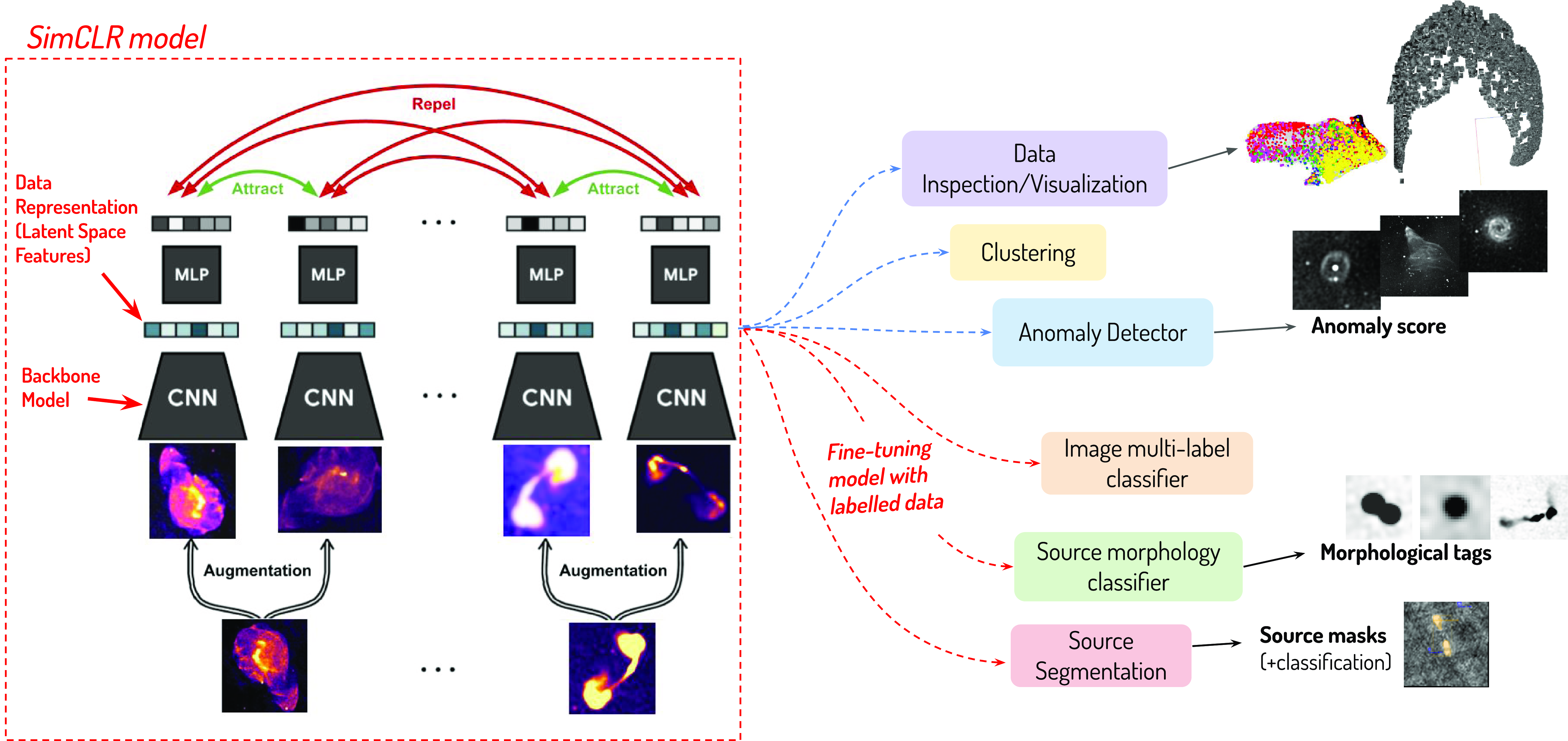
Figure 1. Schema of self-supervised learning for radio data analysis.
The paper is organized as follows. In Section 2 we describe the contrastive learning model considered, along with the training datasets, data pre-processing and training methodologies adopted. In Sections 3, 4, and 5 we studied how the trained self-supervised models perform in the three selected analysis scenarios, reporting performances achieved against benchmark supervised models. Finally, in Section 6 we summarize the obtained results and discuss future steps.
2. Self-supervised learning of radio data
2.1 Contrastive learning model
Figure 1 illustrates how self-supervised learning can be used for radio data analysis. Initially, a self-supervised framework (indicated by the red block) is trained on large samples of unlabelled image data. Subsequently, the resulting model backbone and data representation (or latent space vector) can be utilized for various downstream tasks, such as data inspection or anomaly detection, typically employing dimensionality reduction methods. Furthermore, the model can be applied to source detection and classification analysis using new labelled datasets. In this study, we used SimCLR as the self-supervised framework for our analysis.
SimCLR (Chen et al., 2020) is a simple yet widely used popular self-supervised learning framework. It learns data representations by maximizing the similarity between augmented views of the same input data (positive examples) relative to augmented views of different input data within the same training batch (negative examples). The architecture of SimCLR, depicted in Figure 1, consists of two main components: a base encoder network f, which is typically a ResNet network (He et al., Reference He2016), and a small projection head network g, which is typically a Multi-Layer Perceptron (MLP) with one or two layers. Input images
![]() $\mathbf{x}_{k}$
(k = 1,...,N) in a given batch sample of size N are first processed to produce two augmented views (or positive pair)
$\mathbf{x}_{k}$
(k = 1,...,N) in a given batch sample of size N are first processed to produce two augmented views (or positive pair)
![]() $\hat{\mathbf{x}}_{2k-1}$
and
$\hat{\mathbf{x}}_{2k-1}$
and
![]() $\hat{\mathbf{x}}_{2k}$
, by randomly applying multiple transformations from a specified transform set
$\hat{\mathbf{x}}_{2k}$
, by randomly applying multiple transformations from a specified transform set
![]() $\mathcal{T}$
. The encoder network, also denoted as the backbone model throughout the paper, extracts representation vectors
$\mathcal{T}$
. The encoder network, also denoted as the backbone model throughout the paper, extracts representation vectors
![]() $\mathbf{h}_{2k-1}= f(\mathbf{x}_{2k-1})$
and
$\mathbf{h}_{2k-1}= f(\mathbf{x}_{2k-1})$
and
![]() $\mathbf{h}_{2k}= f(\mathbf{x}_{2k})$
from each augmented data pair. The projector network maps the representations to a space where a contrastive loss is applied, obtaining vectors
$\mathbf{h}_{2k}= f(\mathbf{x}_{2k})$
from each augmented data pair. The projector network maps the representations to a space where a contrastive loss is applied, obtaining vectors
![]() $\mathbf{z}_{2k-1}= g(\mathbf{h}_{2k-1})$
and
$\mathbf{z}_{2k-1}= g(\mathbf{h}_{2k-1})$
and
![]() $\mathbf{z}_{2k}= g(\mathbf{h}_{2k})$
. The contrastive loss
$\mathbf{z}_{2k}= g(\mathbf{h}_{2k})$
. The contrastive loss
![]() $\mathcal{L}$
, which is minimized during model training, is defined as:
$\mathcal{L}$
, which is minimized during model training, is defined as:
where
![]() $l_{i,j}$
is the normalized temperature-scaled cross entropy loss (NT-Xent),
$l_{i,j}$
is the normalized temperature-scaled cross entropy loss (NT-Xent),
![]() $\unicode{x1D7D9}_{k \neq i}$
= 1 if k = i (equal to 0 otherwise),
$\unicode{x1D7D9}_{k \neq i}$
= 1 if k = i (equal to 0 otherwise),
![]() $\tau$
is a temperature parameter, and
$\tau$
is a temperature parameter, and
![]() $\text{sim}(\mathbf{z}_i,\mathbf{z}_j)$
is the pair-wise similarity between vectors
$\text{sim}(\mathbf{z}_i,\mathbf{z}_j)$
is the pair-wise similarity between vectors
![]() $\mathbf{z}_i$
and
$\mathbf{z}_i$
and
![]() $\mathbf{z}_j$
, defined as:
$\mathbf{z}_j$
, defined as:
2.2 Datasets
We created the following unlabelled datasets for training SimCLR:
-
1. Two distinct datasets were generated using data from the SARAO MeerKAT Galactic Plane Survey (SMGPS) (Goedhart et al., Reference Goedhart2024), which covers a large portion of the 1st, 3rd and 4th Galactic quadrants (l = 2
 $^{\circ}$
−61
$^{\circ}$
−61
 $^{\circ}$
, 251
$^{\circ}$
, 251
 $^{\circ}$
−358
$^{\circ}$
−358
 $^{\circ}$
,
$^{\circ}$
,
 $|b| \lt $
1.5
$|b| \lt $
1.5
 $^{\circ}$
) in the L-band (886–1 678 MHz). The survey has an angular resolution of 8′′ and a noise rms of
$^{\circ}$
) in the L-band (886–1 678 MHz). The survey has an angular resolution of 8′′ and a noise rms of
 $\sim$
10-20
$\sim$
10-20
 $\mu$
Jy/beam at 1.3 GHz:
$\mu$
Jy/beam at 1.3 GHz:-
• hulk_smgps: A collection of 178,057 radio images, each of fixed size (256
 $\times$
256 pixels, equivalent to
$\times$
256 pixels, equivalent to
 $\sim$
6.4’
$\sim$
6.4’
 $\times$
6.4’), extracted from SMGPS 1.28 GHz integrated intensity maps. This dataset was created by assuming a sliding window that traverses the entire surveyed area with a shift size equal to half the frame size, resulting in a 50% overlap among frames. The image size was chosen to be large enough to encompass the most extended radio galaxies that might be located in the cutoutFootnote
d
;
$\times$
6.4’), extracted from SMGPS 1.28 GHz integrated intensity maps. This dataset was created by assuming a sliding window that traverses the entire surveyed area with a shift size equal to half the frame size, resulting in a 50% overlap among frames. The image size was chosen to be large enough to encompass the most extended radio galaxies that might be located in the cutoutFootnote
d
; -
• banner_smgps: A collection of 17 062 radio images extracted from SMGPS 1.3 GHz integrated maps, each centered around sources listed in the SMGPS extended source catalogue (Bordiu et al., Reference Bordiu2024). The size of the images varies across the dataset and is set to 1.5 times the size of the source bounding box. The radio sources in this dataset exhibit different morphologies, including single-island, multi-island, and diffuse sources.
-
-
2. Two distinct datasets were generated using data from the ASKAP EMU pilot survey (Norris et al., Reference Norris2021a), which covered approximately 270 deg
 $^{2}$
of the Dark Energy Survey area, achieving an angular resolution of 11′′ to 18′′ and a noise rms of
$^{2}$
of the Dark Energy Survey area, achieving an angular resolution of 11′′ to 18′′ and a noise rms of
 $\sim$
30
$\sim$
30
 $\mu$
Jy/beam at 944 MHz:
$\mu$
Jy/beam at 944 MHz:-
• hulk_emupilot: A collection of 55 773 radio images, each of fixed size (256
 $\times$
256 pixels, equivalent to
$\times$
256 pixels, equivalent to
 $\sim$
8.5’
$\sim$
8.5’
 $\times$
8.5’), extracted from ASKAP EMU pilot 944 MHz integrated map. The images were extracted using a sliding frame that traversed the entire mosaic with a shift size equal to half the frame size, resulting in a 50% overlap among frames.
$\times$
8.5’), extracted from ASKAP EMU pilot 944 MHz integrated map. The images were extracted using a sliding frame that traversed the entire mosaic with a shift size equal to half the frame size, resulting in a 50% overlap among frames. -
• banner_emupilot: A collection of 10,414 radio images extracted from ASKAP EMU pilot 944 MHz integrated map, each centered around extended sources listed in the pilot source catalogue compiled by Gupta et al. (Reference Gupta2024). The size of the images varies across the dataset and is set to 1.5 times the size of the source bounding box. The radio sources in this dataset exhibit different morphologies, including FR-I (
 $\sim$
6%), FR-II (
$\sim$
6%), FR-II (
 $\sim$
54%), FR-x (
$\sim$
54%), FR-x (
 $\sim$
14%), single-peak resolved (
$\sim$
14%), single-peak resolved (
 $\sim$
23%) radio galaxies.
$\sim$
23%) radio galaxies.
 $\sim$
3% of the sources present a rare morphology not fitting into the previously mentioned categories.
$\sim$
3% of the sources present a rare morphology not fitting into the previously mentioned categories.
-
Datasets extracted in a blind mode (e.g. without any previous knowledge of the source location and morphology) can be constructed rapidly, potentially reaching substantial sizes (up to millions of images) when using future full-sky surveys. Without additional selection processes, these datasets tend to be largely unbalanced, predominantly comprising frames composed entirely of compact sources. The hulk_smgps dataset also comprises frames with large-scale diffuse emission, including background or portions of very extended sources located along the Galactic plane. For simplicity, we have labelled them as hulk. In contrast, “smarter” datasets centered on selected source positions typically have smaller sizes, requiring significant efforts (catalogue production and source type annotation) for construction. We have labelled them as banner. Indeed, one goal of this work is evaluating differences and benefits of both kind of datasets over different analysis tasks. Summary information for all produced datasets is reported in Table 1. In Figure 2 we display sample images from the hulk_smgps (top panels), banner_smgps (middle panels) and banner_emupilot (bottom panels) datasets.
Table 1. Summary information of datasets used for SimCLR model training. The number of images
![]() $n_{img}$
is reported in column (2). The image size
$n_{img}$
is reported in column (2). The image size
![]() $s_{img}$
is reported in column (3).
$s_{img}$
is reported in column (3).
![]() $s_{img}$
is fixed for all images in the hulk_smgp and hulk_emupilot datasets, while
$s_{img}$
is fixed for all images in the hulk_smgp and hulk_emupilot datasets, while
![]() $s_{img}$
is not fixed and depends on the source size
$s_{img}$
is not fixed and depends on the source size
![]() $s_{\text{source}}$
(equivalent to the maximum source bounding box dimension) in the banner_smgps and banner_emupilot datasets. For these datasets, we report the average, minimum and maximum source sizes in columns (4), (5) and (6), respectively. Images from all datasets are eventually resized to a fixed size for model training and testing (see Section 2.3).
$s_{\text{source}}$
(equivalent to the maximum source bounding box dimension) in the banner_smgps and banner_emupilot datasets. For these datasets, we report the average, minimum and maximum source sizes in columns (4), (5) and (6), respectively. Images from all datasets are eventually resized to a fixed size for model training and testing (see Section 2.3).

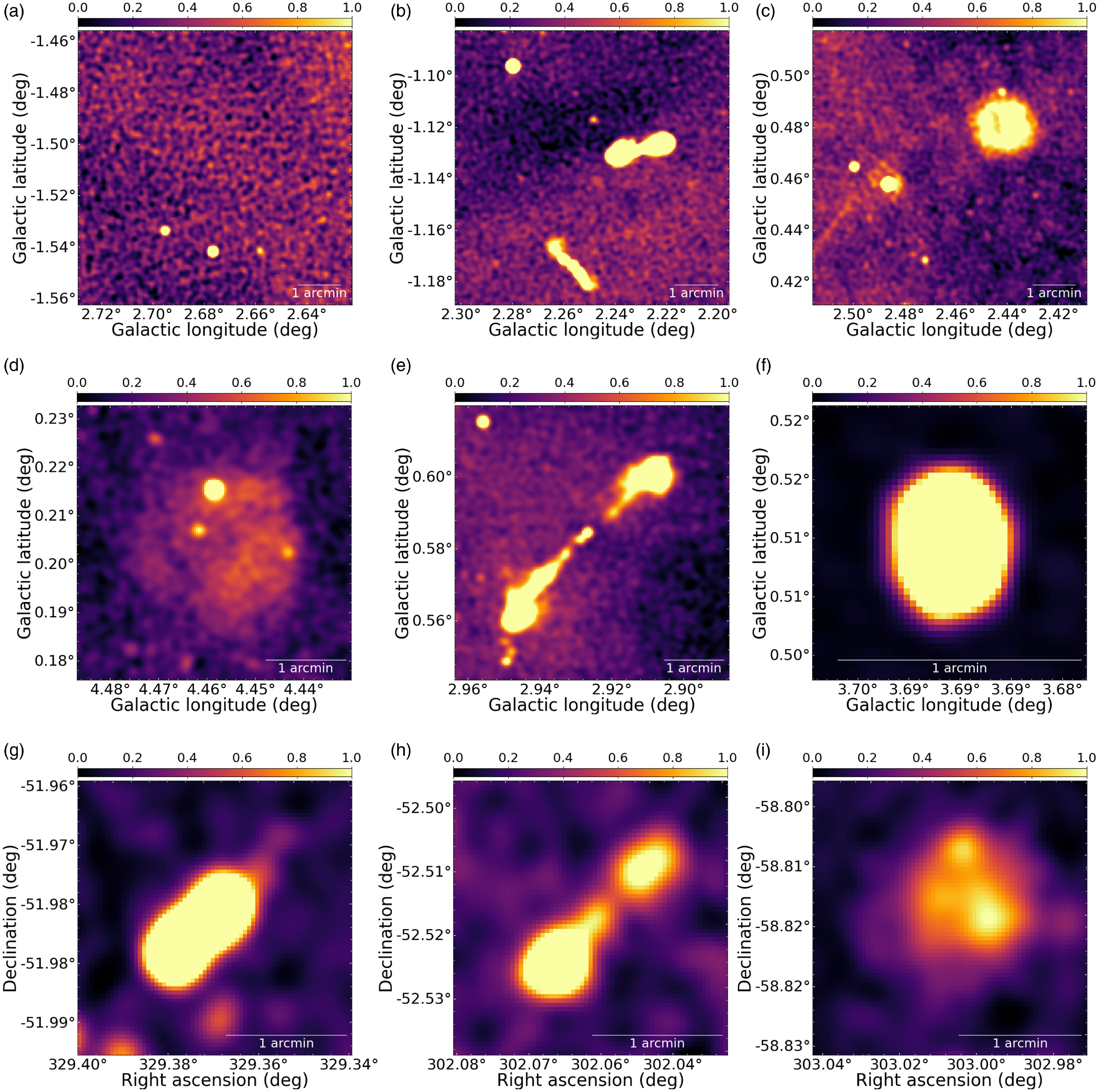
Figure 2. Representative examples of images from the hulk_smgps (top panels), banner_smgps (middle panels) and hulk_emupilot (bottom panels) datasets. A zscale transform was applied to all images for visualization scopes. Top panels: sample images containing only compact sources (Figure 2(a)), or multiple extended sources (Figures 2(b) and 2(c)). Middle panels: sample source with diffuse morphology (Figure 2(d)), a multi-component extended source exhibiting typical radio galaxy morphology (Figure 2(e)), a single-component extended source with a roundish morphology (Figure 2(f)). Bottom panels: sample sources with FR-I (Figure 2(g)), FR-II (Figure 2(h)) and peculiar (Figure 2(i)) classification.
2.3 Data pre-processing and augmentation
For the training and inference stages, we applied these pre-processing steps to input images:
-
• Grayscale images were converted to 3-channels. Each channel was processed differently from others, applying the following transformations:
-
- Channel 1: sigma-clipping (
 $\sigma_{low}$
= 5,
$\sigma_{low}$
= 5,
 $\sigma_{up}$
= 30);
$\sigma_{up}$
= 30); -
- Channel 2: zscale transform (contrast = 0.25);
-
- Channel 3: zscale transform (contrast = 0.4).
-
-
• Each channel was independently normalized to a [0,1] range using a MinMax transformation;
-
• Finally, each channel was resized to a 224
 $\times$
224 size in pixels.
$\times$
224 size in pixels.
A key aspect when training contrastive learning models is the choice of applied data augmentation steps to make the model invariant with respect to non-physical properties or to features not related to the radio sources. We applied the following augmenters to the data sequentially:
-
• RandomCropResize: randomly crop input images to size crop_size
 $\times$
image size, and resize data to the original size. crop_size was randomly varied in the range [0.8, 1.0];
$\times$
image size, and resize data to the original size. crop_size was randomly varied in the range [0.8, 1.0]; -
• ColorJitter: apply a colour jitter transformation using all three image channels;
-
• Flip: random flip images either vertically or horizontally;
-
• Rotate: rotate images by either 90, 180 or 270 degrees;
-
• Blur: apply Gaussian blurring to images using a
 $\sigma$
parameter randomly varied in the range [1,3];
$\sigma$
parameter randomly varied in the range [1,3]; -
• RandomThresholding: threshold each channel separately using a per-channel percentile threshold randomly varied in the range [40,60].
The RandomThresholding augmenter was introduced to make the model less dependent on image background features. This stage was not applied when training over the banner datasets, as images in this dataset are already zoomed on radio sources, and thus the background would likely not be estimated correctly. Furthermore, not all augmenters are applied to every image in the training dataset. In Table 2 we provide a summary of augmenter steps used in the pre-processing pipeline with their parameters, including the probability with which each data transform is applied to images. With respect to Chen et al. (2020), we reduced the fraction of random cropping allowed to avoid cutting out relevant details of extended sources from the resulting image.
2.4 Model training
We trained a SimCLR model on each of the four datasets described in Section 2.2, using the hyperparameters listed in Table 3. We will refer to them using their training dataset name: hulk_smgps, banner_smgps, hulk_emupilot, and banner_emupilot. A fourth model, referred to as smart_hulk_smgps hereafter, was trained in two steps, first on the hulk_smgps dataset and then on the banner_smgps dataset. The final model weights from the first step were used as initialization for the second step. For all models, we used a ResNet18 (He et al., Reference He2016) encoder and a 2-layer projector with 256 and 128 neurons, respectively.
Table 2. List of augmentations used in SimCLR model training. In column (2) we reported the transform parameter values. In column (3) we reported the probability used to apply the transform in the augmentation pipeline, e.g. 1.0 means the transform is always applied to all input images.

Table 3. List of hyperparameters used in SimCLR model training.
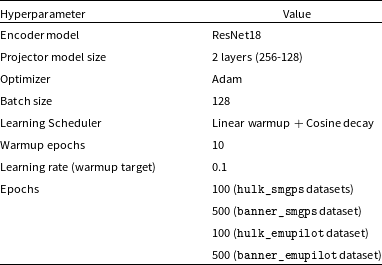
Following Chen et al. (2020), all training runs began with a linear warm-up phase lasting 10 epochs, after which we switched to a cosine learning rate decay strategy. In total, we trained models for 500 epochs on the banner_smgps and banner_emupilot datasets. A smaller total number of epochs (100) was used when training over the larger hulk_smgps and hulk_emupilot datasets to reduce computational costs.
Training runs were performed on three different computing server nodes, each equipped with a GPU device:
-
• Node A: 48 cores (Intel Xeon Gold 6248R CPU, 3.00 GHz), 512 GB RAM, NVIDIA Quadro RTX 6000 (24 GB)
-
• Node B: 24 cores (Intel Xeon Silver 4410Y, 2.00 GHz), 256 GB RAM, NVIDIA A30 (24 GB)
-
• Node C: 36 cores (Intel Xeon CPU E5-2697 v4, 2.30 GHz), 128 GB RAM, NVIDIA Tesla V100 (16 GB)
Typical training times over the hulk_smgps dataset are of the order of
![]() $\sim$
6.7 hours/epoch on nodes A/B, and
$\sim$
6.7 hours/epoch on nodes A/B, and
![]() $\sim$
12.5 hours/epoch on node C.
$\sim$
12.5 hours/epoch on node C.
2.5 Evaluation of downstream tasks
In the following sections, the trained self-supervised models and corresponding data representation will be evaluated on radio source classification (Section 3) and detection (Section 4) tasks using supervised CNN classifiers trained on labelled datasets. Furthermore, in Section 5 we will use the self-supervised features to classify radio images according to the morphology of hosted sources in a supervised way and according to their peculiarity degree in a completely unsupervised way. To estimate the performances achieved in these downstream tasks, we will consistently use these widely adopted metrics in multi-class problems:
-
• Recall (
 $\mathcal{R}$
): Fraction of sources (images) of a given class that were correctly classified by the model out of all sources (images) labelled in that class, computed as:
$\mathcal{R}$
): Fraction of sources (images) of a given class that were correctly classified by the model out of all sources (images) labelled in that class, computed as:  \begin{equation*}\mathcal{R}=\frac{TP}{TP + FN}\end{equation*}
\begin{equation*}\mathcal{R}=\frac{TP}{TP + FN}\end{equation*}
-
• Precision (
 $\mathcal{P}$
): Fraction of sources (images) correctly classified as belonging to a specific class, out of all sources (images) the model predicted to belong to that class, computed as:
$\mathcal{P}$
): Fraction of sources (images) correctly classified as belonging to a specific class, out of all sources (images) the model predicted to belong to that class, computed as: \begin{equation*}\mathcal{P}=\frac{TP}{TP + FP}\end{equation*}
\begin{equation*}\mathcal{P}=\frac{TP}{TP + FP}\end{equation*}
-
• Contamination (
 $\mathcal{C}$
): Fraction of sources (images) of a given class incorrectly classified as belonging to a specific class, out of all sources (images) the model predicted to belong to that class, computed as:
$\mathcal{C}$
): Fraction of sources (images) of a given class incorrectly classified as belonging to a specific class, out of all sources (images) the model predicted to belong to that class, computed as:  \begin{equation*}\mathcal{C}= \frac{FP}{TP + FP}= 1 - \mathcal{P}\end{equation*}
\begin{equation*}\mathcal{C}= \frac{FP}{TP + FP}= 1 - \mathcal{P}\end{equation*}
-
• F1-score: the harmonic mean of precision and recall:
(4) \begin{equation}\text{F1-score}=2\times\frac{\mathcal{P}\times\mathcal{R}}{\mathcal{P}+\mathcal{R}}\end{equation}
\begin{equation}\text{F1-score}=2\times\frac{\mathcal{P}\times\mathcal{R}}{\mathcal{P}+\mathcal{R}}\end{equation}
where TP, FN, FP are the number of true positive, false negative and false positive instances, respectively.
3. Task I: Classification of radio source morphology
In this section, we quantitatively evaluate the learned self-supervised representation on a source morphology classification problem.
Morphological classification plays a pivotal role in radio astronomy, enabling scientists to gain insights into the underlying source nature from the observed shape and structures. The majority of existing works in the radio image domain are targeted for extragalactic science objectives, focusing on classification of radio galaxies (see for example Aniyan & Thorat Reference Aniyan and Thorat2017, Ma et al., Reference Ma2019, or Ndung’u et al., Reference Ndung’u2023 for a recent review) in different morphological classes: compact, FR-I, FR-II, bent-tailed (including WATFootnote e and NATFootnote f population), irregular (including, for example, X-shaped or ring-like radio galaxies).
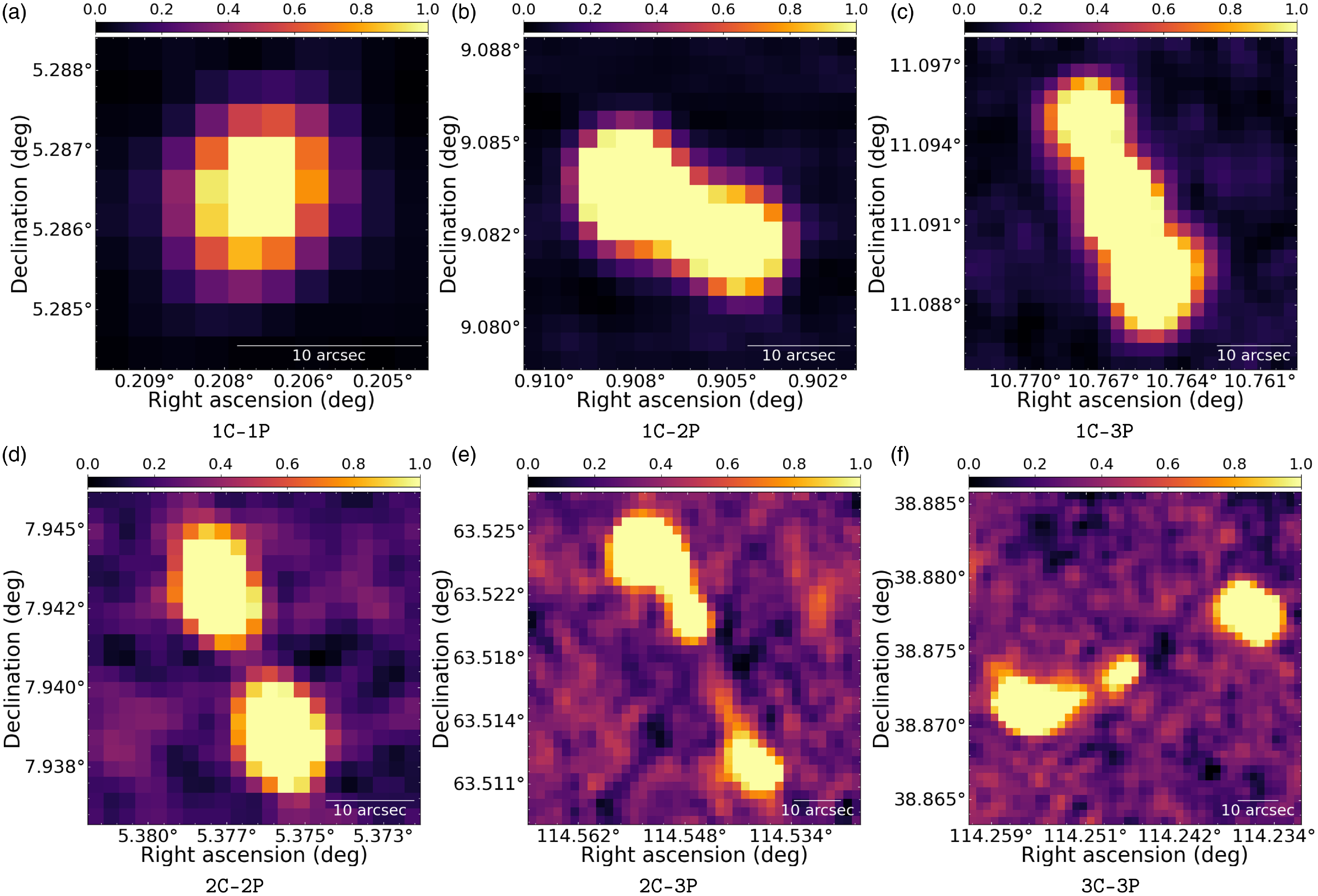
Figure 3. Sample images from the RGZ dataset with representative sources of different morphological classes (reported below each frame). A zscale transform was applied to all images for visualization scopes.
Morphological classification is also an important post-detection stage to filter extracted sources by general morphology (e.g. compact vs extended sources) for specialized source property measurements or other advanced classification analysis. In this context, the adopted source labelling scheme is rather general-purpose and domain-agnostic, suited to be eventually refined afterwards. For example, typical used labels are POINT-LIKE, RESOLVED, COMPACT, EXTENDED or labels that contain information about the number of radio components present in the extracted source (as in Wu et al., Reference Wu2019).
The analysis carried out in this section falls into the second use-case scenario. This choice is mostly driven by existing datasets. Available annotated datasets for radio galaxy classification (mostly based on VLA FIRST survey data) are, in fact, rather limited in size (e.g. typically <100-200 images per class, <2000 images overall) and would currently prevent us from obtaining a robust evaluation of our self-supervised models over multiple test set realizations. For example, the Mirabest dataset (Porter & Scaife Reference Porter and Scaife2023) contains 1256 source images of balanced FR-I/FR-II radio galaxy classes, out of which 833 images constitute the “Confident” sample, and the rest (423 images) the “Uncertain” sample. On this dataset, Slijepcevic et al. (Reference Slijepcevic2024) reported an improvement of
![]() $\sim$
3-4% in classification performance of a self-supervised pre-trained model with respect to a fully supervised model trained from scratch on the “Confident” sample (or on a portion of it). Classification metrics were, however, estimated on the “Uncertain” sample, and hence the observed enhancement is due to less than 20 sources. We, therefore, opted for this work to use a larger dataset (roughly by one order of magnitude) and perform a similar analysis once a larger dataset is assembled within the ASKAP EMU survey.
$\sim$
3-4% in classification performance of a self-supervised pre-trained model with respect to a fully supervised model trained from scratch on the “Confident” sample (or on a portion of it). Classification metrics were, however, estimated on the “Uncertain” sample, and hence the observed enhancement is due to less than 20 sources. We, therefore, opted for this work to use a larger dataset (roughly by one order of magnitude) and perform a similar analysis once a larger dataset is assembled within the ASKAP EMU survey.
3.1 Dataset
For this analysis, we considered data from the Radio Galaxy Zoo (RGZ) projectFootnote
g
(Banfield et al., Reference Banfield2015). This includes radio images of size 3’
![]() $\times$
3’ from the VLA Faint Images of the Radio Sky at Twenty cm (FIRST) survey (1.4 GHz, angular resolution
$\times$
3’ from the VLA Faint Images of the Radio Sky at Twenty cm (FIRST) survey (1.4 GHz, angular resolution
![]() $\sim$
5′′) (Becker et al., Reference Becker1995). Radio sources found in these images were labelled into multiple morphological classes, on the basis of the observed number of components (C) and peaks (P) (see Wu et al. Reference Wu2019 for more details on the classification schema). Angular size is also available for each source.
$\sim$
5′′) (Becker et al., Reference Becker1995). Radio sources found in these images were labelled into multiple morphological classes, on the basis of the observed number of components (C) and peaks (P) (see Wu et al. Reference Wu2019 for more details on the classification schema). Angular size is also available for each source.
In this analysis, we extracted 82 084 image cutouts around radio sources that have been classified in the RGZ Data Release 1 (DR1) with a consensus level
![]() $\ge$
0.6 in the following classes: 1C-1P (55.0%), 1C-2P (20.9%), 1C-3P (1.9%), 2C-2P (17.6%), 2C-3P (2.0%), 3C-3P (2.5%). We assumed a cutout size equal to 1.5
$\ge$
0.6 in the following classes: 1C-1P (55.0%), 1C-2P (20.9%), 1C-3P (1.9%), 2C-2P (17.6%), 2C-3P (2.0%), 3C-3P (2.5%). We assumed a cutout size equal to 1.5
![]() $\times$
the source angular size, as listed in the RGZ catalogue. A representative image of each source morphological category is shown in Figure 3.
$\times$
the source angular size, as listed in the RGZ catalogue. A representative image of each source morphological category is shown in Figure 3.
As the full dataset is largely unbalanced towards sources of class morphology 1C-1P, we randomly created
![]() $N_{sets}$
= 5 balanced training and test sets having 1000 and 600 images per class, respectively. Both training and test set images were pre-processed as described in Section 2.3 for the SimCLR model training.
$N_{sets}$
= 5 balanced training and test sets having 1000 and 600 images per class, respectively. Both training and test set images were pre-processed as described in Section 2.3 for the SimCLR model training.
3.2 Evaluation of self-supervised representation
In Figure 4 we present a two-dimensional projection, obtained with the Uniform Manifold Approximation and Projection (UMAP) (McInnes et al., 2018) dimensionality reduction algorithm, of the representation vector (original size equal to 512) produced by the trained smart_hulk_smgps model on the RGZ dataset. As can be observed, the self-supervised model effectively groups sources of different morphological class in distinct areas of the latent space. No isolated clusters are discernible in the projected two-dimensional UMAP feature space, as well as in a PCA scatter plot of top-2 features (not shown here). Nevertheless, these or similar diagnostic plots, can be useful for potentially identifying possible image mislabeling in the dataset, e.g. sources that fall within a region that is predominantly populated by other classes.
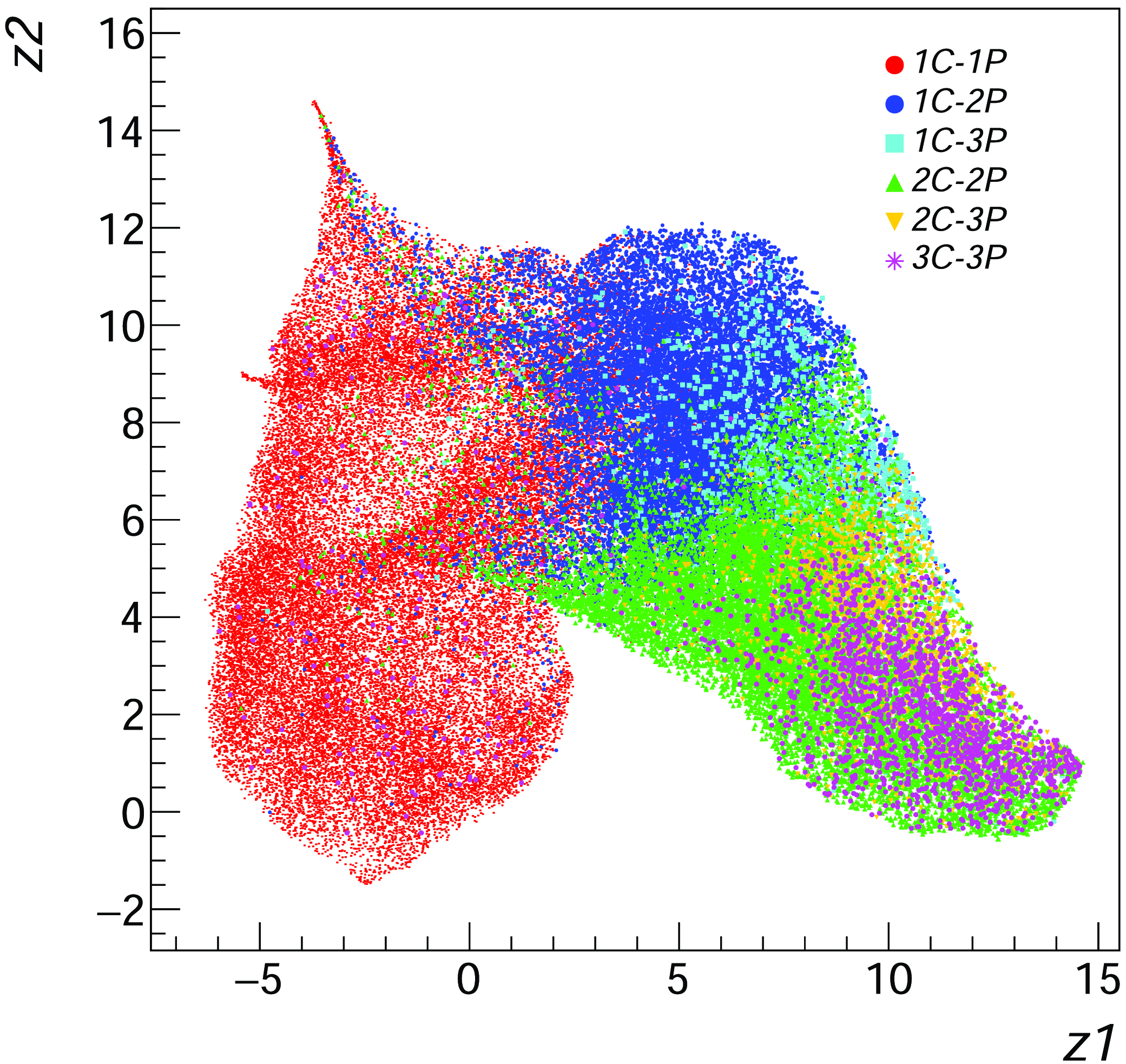
Figure 4. 2D UMAP projection of the data representation vector (size = 512) produced by the trained smart_hulk_smgps model on the RGZ dataset.
We carried out a classification analysis using a CNN classifier with a standard architecture: a ResNet18 backbone model (as in the SimCLR model) followed by a classification head. The latter consists of a single layer followed by a softmax activation, representing the predicted probability distribution over the set of classes. To evaluate the quality of the self-supervised representation, we froze the backbone model, setting and fixing its weights to those obtained in the trained SimCLR models, and trained only the classification head on RGZ training datasets for a limited number of epochs (30). We considered only rotation and flipping transformations as augmentation steps during the training.
In Figure 5 we report the classification F1-scores obtained on the test set by different self-supervised pre-trained models: hulk_smgps (red squares), banner_smgps (blue inverted triangles), smart_hulk_smgps (green triangles), hulk_emupilot (orange diamonds), banner_emupilot (cyan asterisks). The reported values and their errors are respectively the F1-score mean and mean error computed over the available test sets. These metrics were compared against those obtained with a baseline model pre-trained on the ImageNet-1k datasetFootnote h Deng et al., Reference Deng2009) (trained on non-radio data), shown with black dots in Figure 5. We found that self-supervised pre-trained models reach approximately 7–12% better overall scores with respect to the baseline, due to the higher quality features obtained on complex and extended sources, which are not as well represented in the ImageNet dataset. Another valuable indication is that the two-step pre-training approach done for the smart_hulk_smgps model training provide better results compared to training over random or source-centred images alone. The improvement is, however, not very significant with respect to the hulk_smgps, likely due to both the limited size of the banner_smgps dataset and the absence of Galactic-like diffuse and extended sources in the RGZ dataset. By construction, we expect that the banner_smgps model should be more specialized for this kind of source morphologies. This will be tested in a future analysis once we finalize a new test dataset with diffuse sources taken from ASKAP EMU observations.
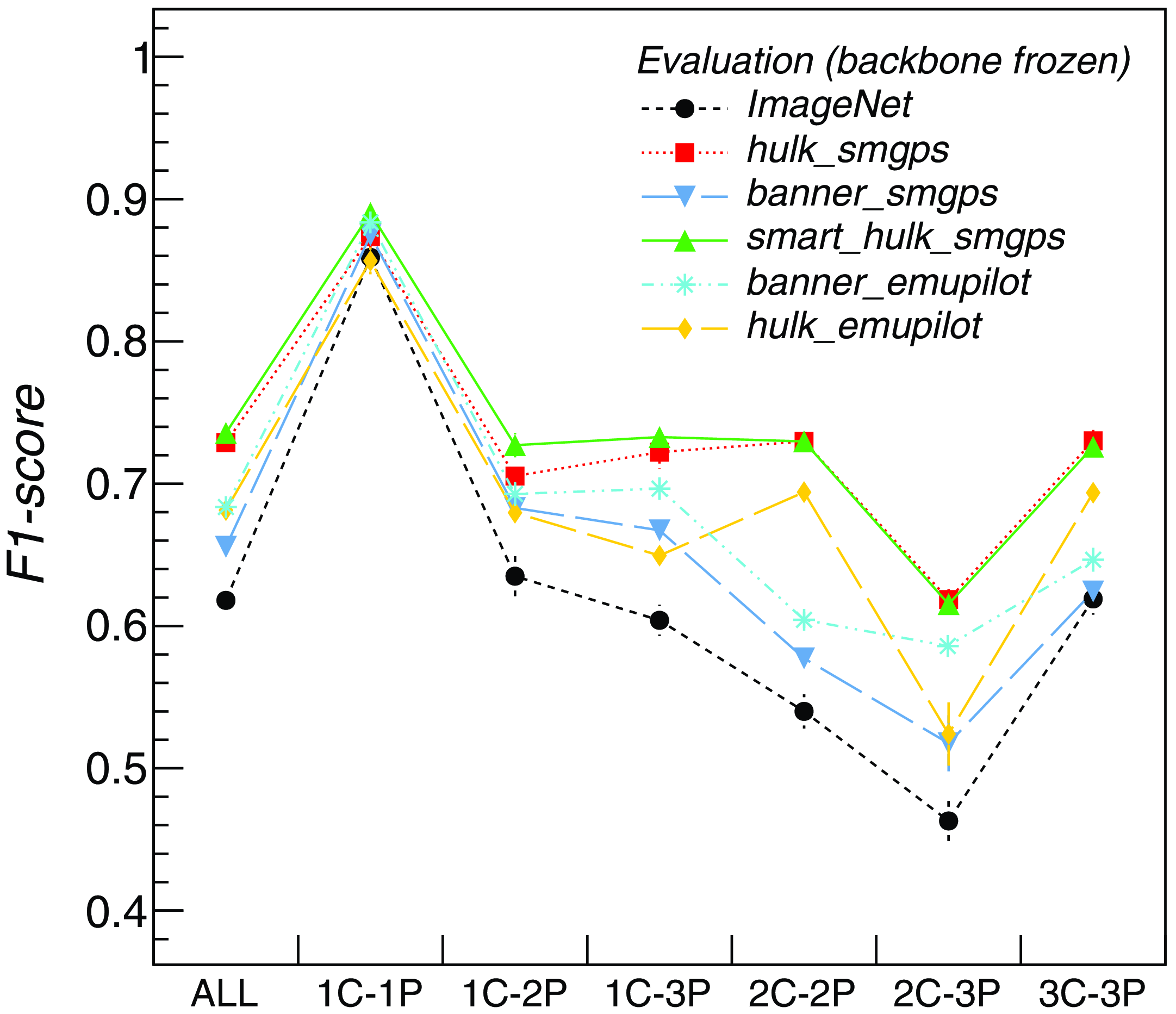
Figure 5. Classification F1-scores obtained for different classes and for all classes cumulatively over RGZ test sets with different pre-trained and frozen backbone models: hulk_smgps (red squares), banner_smgps (blue inverted triangles), smart_hulk_smgps (green triangles), hulk_emupilot (orange diamonds), banner_emupilot (cyan asterisks), ImageNet (black dots). The reported values and errors are the F1-score mean and mean error computed over five test sets.
In Figure 6 we report the confusion matrix obtained over the RGZ test sample with a hulk_smgps pre-trained and frozen backbone model. The obtained misclassification rates suggest that a considerable fraction (10% to 20%) of sources, particularly those with two or three components, may be hard to be correctly distinguished from other classes. After a visual inspection of the misclassified sources, we found that in some cases the misclassification is rather due to dataset mislabelling, e.g. the ground truth label present in the dataset is not correct and the model is indeed predicting the expected class. Some examples are reported in Figure A.1. Future analysis should therefore take into consideration a revision of the RGZ dataset annotation.
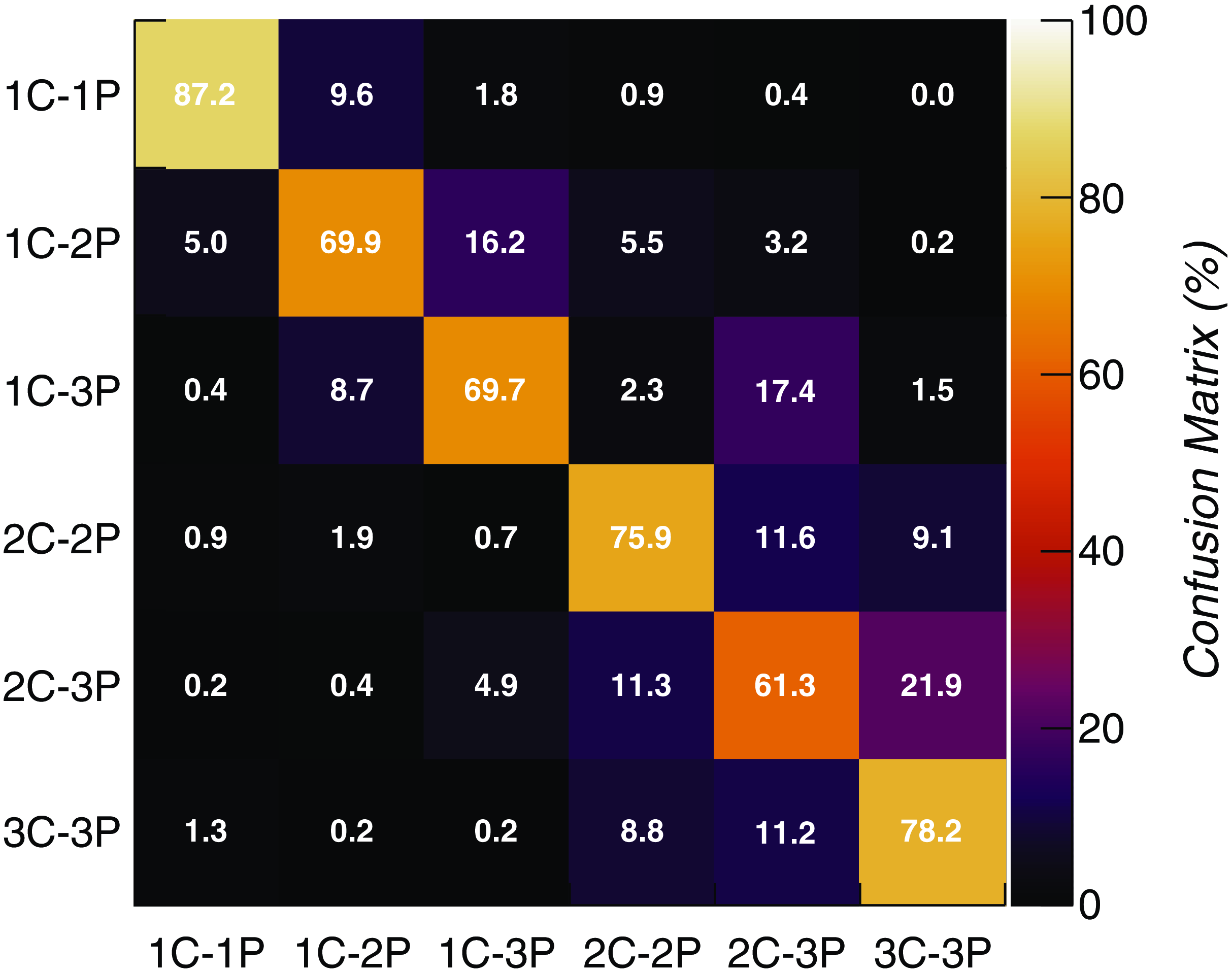
Figure 6. Confusion matrix of the source morphology classifier (trained with smart_hulk_smgps pre-trained and frozen backbone model) obtained over the RGZ test set.
3.3 Model fine-tuning
We fine-tuned the source classifier by unfreezing backbone model layers (e.g. training them along with the classification head) and compared the accuracies reached by two models: one initialized with random weights (e.g. training from scratch), and the other with backbone model weights initialized to the smart_hulk_smgps backbone model weights (best performing model found in Section 3.2). We compared the results of both models when trained on the full training sets and when trained on smaller training sets, obtained by gradually removing labelled data randomly from the original set. In all cases, models were trained for 150 epochs. The test sets were kept unchanged to compute the classification accuracies. This was done to study how the model performs in the recurring scenario in which the amount of labelled data is significantly limited. We reported the results in Figure 7. As can be seen, the fully supervised model (trained from scratch) becomes almost untrainable, providing poor classification metrics, in the small number of labels regime. This occurs for the RGZ dataset below a fraction of approximately 10% of the original training dataset, corresponding to about 600 images (e.g.
![]() $\sim$
100 images per class). On the other hand, self-supervised pre-training enables to fine-tune the model even with few labels, achieving considerably better metrics (>20%). Above the 10% label fraction threshold, the fully supervised model achieved slightly better scores, highlighting that no significant performance benefits are obtained from the pre-training process, at least with the model and dataset sample sizes available for this work. This result is qualitatively on par with the results of the transfer learning analysis carried out by Chen et al. (2020) (Section B.8.2) on 12 natural image datasets (Food, CIFAR10, CIFAR100,) with ResNet50 architectures of different widths (x1, x2, x4). The authors compared the fine-tuning classification accuracies reached by SimCLR against a supervised model baseline. With wider networks (ResNet50 x4), the self-supervised model was found to outperform the supervised one in 7 datasets (Chen et al. 2020, Table 8). The opposite was however observed with the narrower ResNet50, where the supervised baseline best performed in 10 datasets (Chen et al. 2020, Table B5) out of 12. Our analysis, carried out with an even smaller network (ResNet18), may well fall into the latter case. In either cases, the observed accuracy differences are smaller than 1% for most datasets.
$\sim$
100 images per class). On the other hand, self-supervised pre-training enables to fine-tune the model even with few labels, achieving considerably better metrics (>20%). Above the 10% label fraction threshold, the fully supervised model achieved slightly better scores, highlighting that no significant performance benefits are obtained from the pre-training process, at least with the model and dataset sample sizes available for this work. This result is qualitatively on par with the results of the transfer learning analysis carried out by Chen et al. (2020) (Section B.8.2) on 12 natural image datasets (Food, CIFAR10, CIFAR100,) with ResNet50 architectures of different widths (x1, x2, x4). The authors compared the fine-tuning classification accuracies reached by SimCLR against a supervised model baseline. With wider networks (ResNet50 x4), the self-supervised model was found to outperform the supervised one in 7 datasets (Chen et al. 2020, Table 8). The opposite was however observed with the narrower ResNet50, where the supervised baseline best performed in 10 datasets (Chen et al. 2020, Table B5) out of 12. Our analysis, carried out with an even smaller network (ResNet18), may well fall into the latter case. In either cases, the observed accuracy differences are smaller than 1% for most datasets.

Figure 7. Classification F1-scores obtained (for all classes cumulatively) over RGZ test sets as a function of the number of images
![]() $n_{train}$
in the training set with two alternative models: one trained from scratch (open black dots), the other trained with backbone model weights initialized to smart_hulk_smgps weights (filled black dots). The upper x-axis indicates the fraction of the full training set considered in each training run.
$n_{train}$
in the training set with two alternative models: one trained from scratch (open black dots), the other trained with backbone model weights initialized to smart_hulk_smgps weights (filled black dots). The upper x-axis indicates the fraction of the full training set considered in each training run.
4. Task II: Radio source detection
In this section, we quantitatively evaluate the learned self-supervised representation on an instance segmentation problem, specifically the detection of radio sources with various morphologies.
Algorithms used in traditional radio source finders are not well-suited for detecting extended radio sources with diffuse edges, and they are unable to detect extended sources that are composed of multiple disjoint regions. To address this limitation, new source finders (Wu et al., Reference Wu2019; Mostert et al., Reference Mostert2022; Zhang et al., Reference Zhang2022; Yu et al., Reference Yu2022; Riggi et al., Reference Riggi2023; Lao et al., Reference Lao2023; Gupta et al., Reference Gupta2024; Cornu et al., Reference Cornu2024) based on deep neural networks and object detection frameworks have been developed and trained on either simulated or real radio data. Core components of these models are deep CNN backbones and transformer architectures, both of which have millions of parameters that need to be optimized during training. Although these models offer a substantial advancement in extended radio galaxy detection, their performance is limited by the small size (few thousand images) and the imbalance of objects in the available radio training datasets. Additionally, there is a potential performance drop (up to 10% in Riggi et al., Reference Riggi2023) when transferring a trained model to data produced by a different survey or telescope, especially if the new data has a better angular resolution (Tang et al., Reference Tang2019). To improve the training stage, it is a common practice to use models pre-trained on much larger annotated samples of non-astronomical images, such as the ImageNet-1k (Deng et al., Reference Deng2009,
![]() $\sim$
1.28 million images) or the COCO (Tsung-Yi et al. Reference Tsung-Yi2014, 328 000 images) datasets. In this scenario, it is worth exploring whether foundational models built with self-supervised methods on unlabelled radio data can offer performance benefits over non-radio foundational models, especially with small datasets.
$\sim$
1.28 million images) or the COCO (Tsung-Yi et al. Reference Tsung-Yi2014, 328 000 images) datasets. In this scenario, it is worth exploring whether foundational models built with self-supervised methods on unlabelled radio data can offer performance benefits over non-radio foundational models, especially with small datasets.
4.1 caesar-mrcnn source detector
For this analysis, we used the caesar-mrcnn source detector (Riggi et al., Reference Riggi2023), based on the Mask R-CNN object detection framework (He et al., Reference He2017), to extract source segmentation masks and predicted class labels from input radio images. With respect to our original work (Riggi et al., Reference Riggi2023), we have upgraded the software to TensorFlow 2.x, producing a new refactored versionFootnote i with an improved data pre-processing pipeline and support for additional backbone models.
In this context, we would like to make a brief preamble and clarify the motivations that guided the development of the caesar-mrcnn source detector, as these were either misinterpreted or inaccurately presented in other works. Additionally, we aim to address certain conceptual aspects that we realize are often source of confusion within this field.
It is essential to recognize that source detection (or extraction), classification and source characterization (or measurement) represent distinct conceptual stages. A source detector, to be defined as such, should focus solely on extracting source bounding boxes or, preferably, pixel masks, which are the inputs required for the source measurement or classification stages. The source measurement step, on the other hand, is responsible for estimating source properties such as position, flux density, and shape from the outputs of the source detection. Strictly speaking, this step is not required in a source detector, as assumed in Lao et al. (Reference Lao2023). From a methodological standpoint, it is advisable to avoid conflating these stages. This may allow addressing numerous use cases simultaneously, but it can also be counterproductive, leading, for example, to design compromises and overly complex models with multiple loss components to be balanced during training. The resulting models likely have a higher chance of underperforming on both tasks (detection or characterization) with respect to models that are designed and optimised for a specific task. For this reason, source characterization metrics should be independently evaluated and not mixed with the detection metrics, as required, for example, in the SKA Data Challenge 1 (Bonaldi et al., Reference Bonaldi2021) scoring function. When we designed the caesar-mrcnn source detector, we deliberately did not provide a source characterization stage. As we already implemented source measurement functions in the caesar source finder, we rather aim to interface both codes and, at best, add new developments for improvements in specific areas, such as low S/N source characterization and source deblending, as discussed in Boyce et al. (Reference Boyce2023).
In recent ML-based source extractors, source classification was typically performed alongside the detection step, often to classify extracted sources into compact and extended classes of radio galaxies (FR-I, FR-II, etc.). We aimed for our source detector to be general-purpose, portable, and not tied to a specific radioastronomical domain. Therefore, in our view, the detection step should, at a minimum, classify between real and spurious sources, or, at most, between domain-agnostic morphological classes. More refined or domain-specific classification schemes can be more effectively applied afterwards in specialized classifiers working on source-centered images obtained from the detection step. These considerations were the rationale behind the general class labeling scheme adopted in caesar-mrcnn (briefly reported in the following Section).
4.2 Dataset
To train and test caesar-mrcnn, we considered the dataset described in Riggi et al., Reference Riggi2023), which contains 12 774 annotated radio images from different surveys, including VLA FIRST, ATCA Scorpio (Umana et al., Reference Umana2015), and ASKAP-EMU Scorpio (Umana et al., Reference Umana2021). The annotation data consist of pixel segmentation masks and classification labels for a total of 38 342 objects (both real and spurious sources) present in the dataset images. Five object classes were defined:
-
• SPURIOUS: imaging artefacts around bright sources, having a ring-like or elongated compact morphology;
-
• COMPACT: single-island isolated point- or slightly resolved compact radio sources with one or more blended components, each with morphology similar to the synthesized beam shape;
-
• EXTENDED: radio sources with a single-island extended morphology, with one or more blended components, some morphologically different from the synthesized beam shape;
-
• EXTENDED-MULTISLAND: radio sources with an extended morphology, consisting of more than one island, each eventually containing one or more blended components, having a point-like or an extended morphology;
-
• FLAGGED: poorly-imaged single-island radio sources, highly contaminated by nearby imaging artefacts.
For more details on the dataset labelling schema and rationale, we refer the reader to the original work. We also define a generic class label SOURCE for analysis purposes, including real and non-flagged sources, i.e. object instances of class COMPACT, EXTENDED, or EXTENDED-MULTISLAND. Though it is planned, the dataset does not presently contain images and annotation data for Galactic diffuse objects. Indeed, none of existing ML-based finders have been trained to detect diffuse sources other than radio galaxy diffuse structures (e.g. lobe components). The latter are the only diffuse structures present in our dataset, but we never noted to obtain poor detection performances on them, as reported in Ndung’u et al. (Reference Ndung’u2023).
In Figure 8 we present sample images from the dataset, including representative sources for each class. Given that the current dataset is significantly skewed towards compact sources (comprising approximately 80% of the annotated objects), we created five re-balanced training samples, each containing 3245 images, with the following class distributions: SPURIOUS (1464 objects, 14.4%), COMPACT (5457 objects, 53.6%), EXTENDED (2042 objects, 20.1%), EXTENDED-MULTISLAND (1047, 10.3%), FLAGGED (169 objects, 1.7%). The remaining data was reserved to create five test samples, each containing 5110 images, with the following class distributions: SPURIOUS (1022 objects, 6.6%), COMPACT (12.346 objects, 80.0%), EXTENDED (1307 objects, 8.5%), EXTENDED-MULTISLAND (636, 4.1%), FLAGGED (122 objects, 0.8%).

Figure 8. Sample images (taken from Riggi Reference Riggi2023) from the dataset used for caesar-mrcnn training/testing, including objects of different classes: a FLAGGED object (Figure 8(a), in gray), COMPACT objects (in blue), a MULTI-ISLAND object (Figure 8(b), in orange), EXTENDED objects (Figure 8(c), in yellow), SPURIOUS objects (Figure 8(d), in red).
4.3 Evaluation of self-supervised representation
To assess the effectiveness of the self-supervised representation, we followed the procedure outlined in Section 3.2. We froze the Mask R-CNN ResNet18 backbone model, setting and keeping its weights fixed to those obtained in the trained SimCLR models, and trained the remaining components (region proposal network, classification and bounding box regression head, mask prediction head) on multiple training datasets for a set number of epochs (250). The parameters of Mask R-CNN were configured to match the values optimized in our previous work (refer to Riggi Reference Riggi2023, Table A1). We applied the same pre-processing transformations used for training the self-supervised models (as detailed in Section 2.3). During training, we applied three distinct image augmentations: rotation, horizontal/vertical flipping, and zscale transformation with random contrast in the range of 0.25 to 0.4.
The performance of source detection was evaluated on the test sets using the metricsFootnote j defined in Section 2.5 and the following detection/classification criteria:
-
1. Object detection score threshold equal to 0.5;
-
2. Intersection-over-Union (IoU) match threshold between detected and ground truth object masks equal to 0.6;
-
3. Object classified in the SOURCE class group.
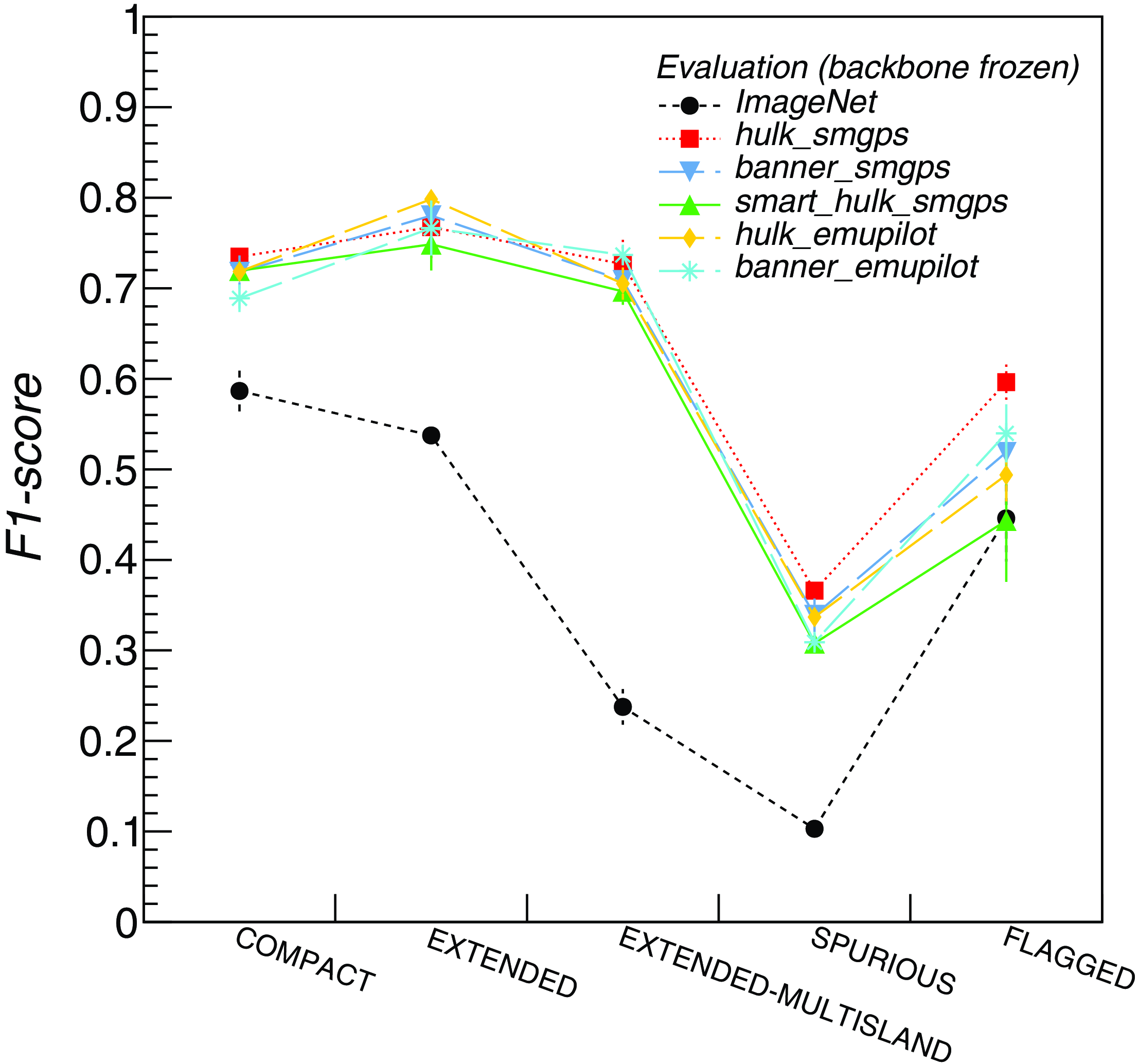
Figure 9. Mask R-CNN object detection F1-score metric obtained for different object classes over multiple test sets with different pre-trained and frozen backbone models: hulk_smgps (red squares), banner_smgps (blue iverted triangles), smart_hulk_smgps (green triangles), hulk_emupilot (orange diamonds), banner_emupilot (cyan asterisks), ImageNet (black dots). The reported values and errors are the means and mean errors computed over 5 test sets.
The above metrics were computed for each class label and reported in Figure 9 for different models trained with frozen self-supervised backbone model weights: hulk_smgps (red squares), banner_smgps (blue triangles), smart_hulk_smgps (green triangles), hulk_emupilot (orange diamonds). Metrics obtained with frozen ImageNet weights are shown with black dots. The performance boost obtained with self-supervised models is significant, around 15%-20% for most classes, and even larger for multi-island sources and imaging artefacts. This is somehow expected, given that these structures are not present in the ImageNet dataset. Overall, for the source class group we are interested in, we did not notice significant differences among trained self-supervised models, after taking into account the run-to-run statistical uncertainties on the obtained metrics. We will therefore consider a representative model (hulk_smgps) in the following fine-tuning analysis.
4.4 Model fine-tuning
We fine-tuned the Mask R-CNN model using random initialization weights (training from scratch) and weights initialized to hulk_smgps self-supervised model. We computed the object detection metrics over the source class group as a function of the training sample size, following the same approach discussed in Section 3.3. Results are reported in Figure 10. Black filled dots are the F1-scores obtained with the pre-trained hulk_smgps model, while open black dots are those found when training from scratch. In this case, we did not observe a significant benefit from using self-supervised pre-training compared to the source classification task studied in Section 3. The improvement in performance in the low label regime (<10% of the original training sample size) is, in fact, of the order of a few percent. This behaviour highlights that other Mask R-CNN components likely play a major role in the overall model detection performance with respect to the backbone model.
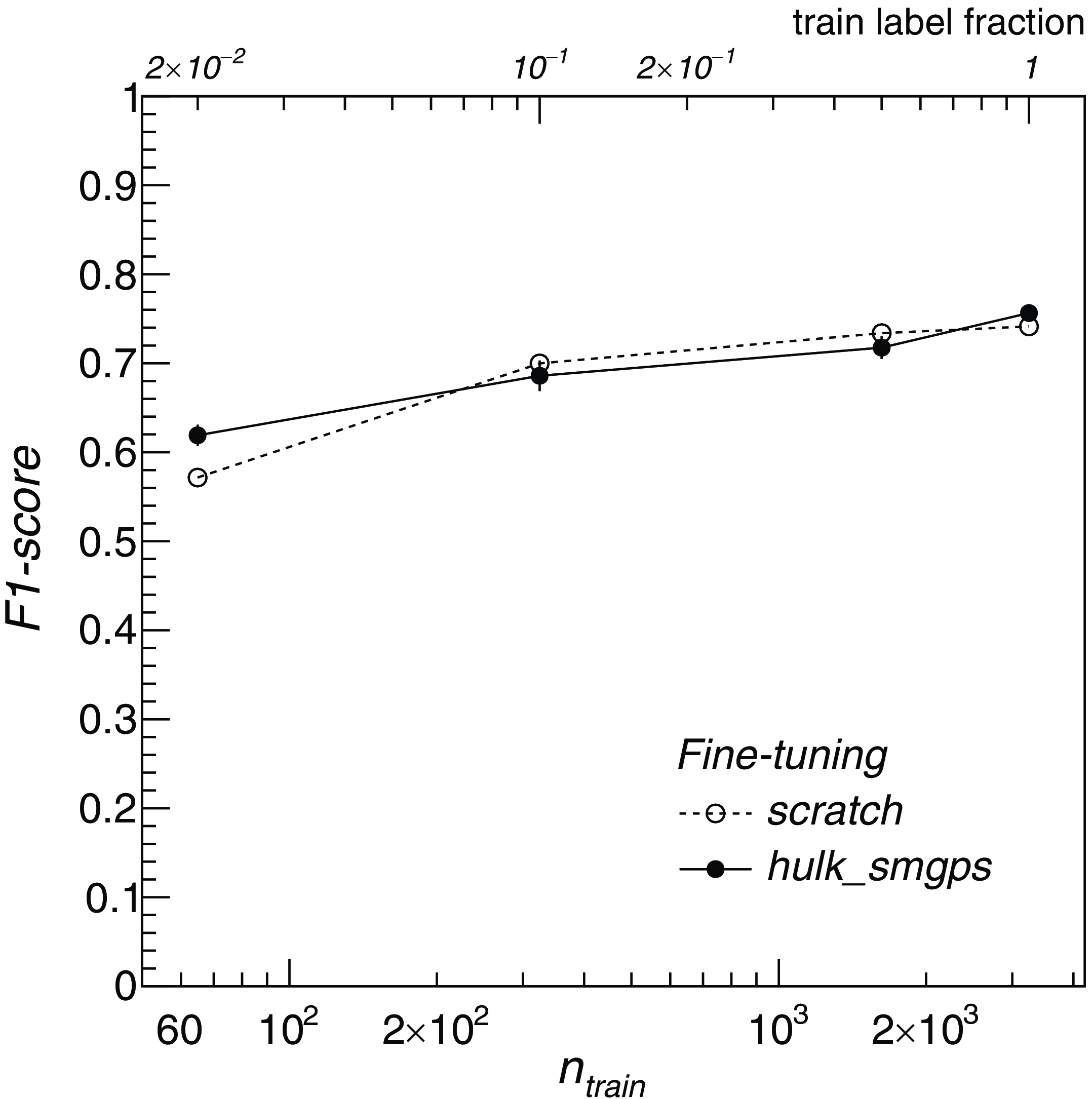
Figure 10. Mask R-CNN object detection F1-score metric obtained over the SOURCE class over multiple test sets as a function of the number of images
![]() $n_{train}$
in the training set with two alternative models: one trained from scratch (open markers), the other trained with backbone model weights initialized to hulk_smgps weights (filled markers). The upper x-axis indicates the fraction of the full training set considered in each training run.
$n_{train}$
in the training set with two alternative models: one trained from scratch (open markers), the other trained with backbone model weights initialized to hulk_smgps weights (filled markers). The upper x-axis indicates the fraction of the full training set considered in each training run.
5. Task III: Search for peculiar objects
In this section, we quantitatively evaluated the learned self-supervised representations in an anomaly detection problem, i.e. employing them for an unsupervised search of radio objects with peculiar morphologies.
Next-generation radio surveys carried out with SKA precursor telescopes are already generating a huge amount of data. Serendipitous discoveries were already reported and obtained by visual inspection of the observed maps. For instance, Norris et al. (Reference Norris2021b) and Koribalski et al. (Reference Koribalski2021) discovered a class of diffuse objects with a roundish shape, dubbed Odd Radio Circles (ORCs), in the ASKAP EMU pilot survey, that did not correspond to any types of object or artifacts known to have similar morphological features. As it is extremely likely that new discoveries are still waiting to be found in such data deluge, astronomers have started to explore ML-based methods to automatically search for objects with peculiar morphologies. In this process, various methods were proposed, allowing to rediscover previously identified anomalies (including the first detected ORCs) and identify completely new objects (Gupta et al., Reference Gupta2022; Lochner et al., Reference Lochner2023).
In this context, two major methodologies were used. Gupta et al. (Reference Gupta2022) and Mostert et al. (Reference Mostert2021) employed rotation and flipping invariant self-organizing maps (SOMs) to search for anomalies in the ASKAP EMU pilot and LOFAR LoTSS survey data, respectively. Both analysis used images of fixed size (approximately 1’ to 5’,
![]() $\sim$
150 pixels per size), centered around previously catalogued radio sources. The Euclidean distance from each “representative” image in the SOM lattice was used as an “anomaly proxy”, e.g. anomalous images have larger Euclidean distances from their closest SOM template image.
$\sim$
150 pixels per size), centered around previously catalogued radio sources. The Euclidean distance from each “representative” image in the SOM lattice was used as an “anomaly proxy”, e.g. anomalous images have larger Euclidean distances from their closest SOM template image.
Segal et al. (Reference Segal2023) used a coarse-grained complexity metric as an “anomaly” proxy to detect peculiar objects in the ASKAP EMU pilot survey. Their method is based on the idea that image frames containing complex and anomalous objects have a higher Kolmogorov complexity compared to ordinary frames. In contrast to the previously mentioned methods, Segal et al. (Reference Segal2023) conducted a blind search by sliding fixed image frames of size 256
![]() $\times$
256 pixels (
$\times$
256 pixels (
![]() $\sim$
12 arcmin) through the entire map, rather than focusing on frames centered around known source positions. An approximated complexity estimation for each frame was then computed from the compression file size (using the gzip algorithm) of smoothed and resized frames. This allowed the authors to obtain a catalogue of peculiar sources at different reliability levels, corresponding to different complexity threshold choices. The complexity metric is conceptually simple and fast to compute, which is undoubtedly a positive aspect of this method. However, as noted by Mostert et al. (Reference Mostert2021), the complexity metric may not fully capture the morphological features of the sources present in the images.
$\sim$
12 arcmin) through the entire map, rather than focusing on frames centered around known source positions. An approximated complexity estimation for each frame was then computed from the compression file size (using the gzip algorithm) of smoothed and resized frames. This allowed the authors to obtain a catalogue of peculiar sources at different reliability levels, corresponding to different complexity threshold choices. The complexity metric is conceptually simple and fast to compute, which is undoubtedly a positive aspect of this method. However, as noted by Mostert et al. (Reference Mostert2021), the complexity metric may not fully capture the morphological features of the sources present in the images.
A potential limitation of “source-centric” approaches could be their reliance on catalogues created with traditional source finding algorithms, which are known to have a higher likelihood of missing diffuse sources (a primary target in anomaly searches). Nevertheless, existing studies successfully manage to identify new anomalous sources in their datasets. Mostert et al. (Reference Mostert2021) also noted that their method is not fully sensitive to detect anomalies at angular scales much smaller than the chosen image size (100 arcsec in their work). The choice of the frame size is an aspect that certainly affects “blind” anomaly searches as well.
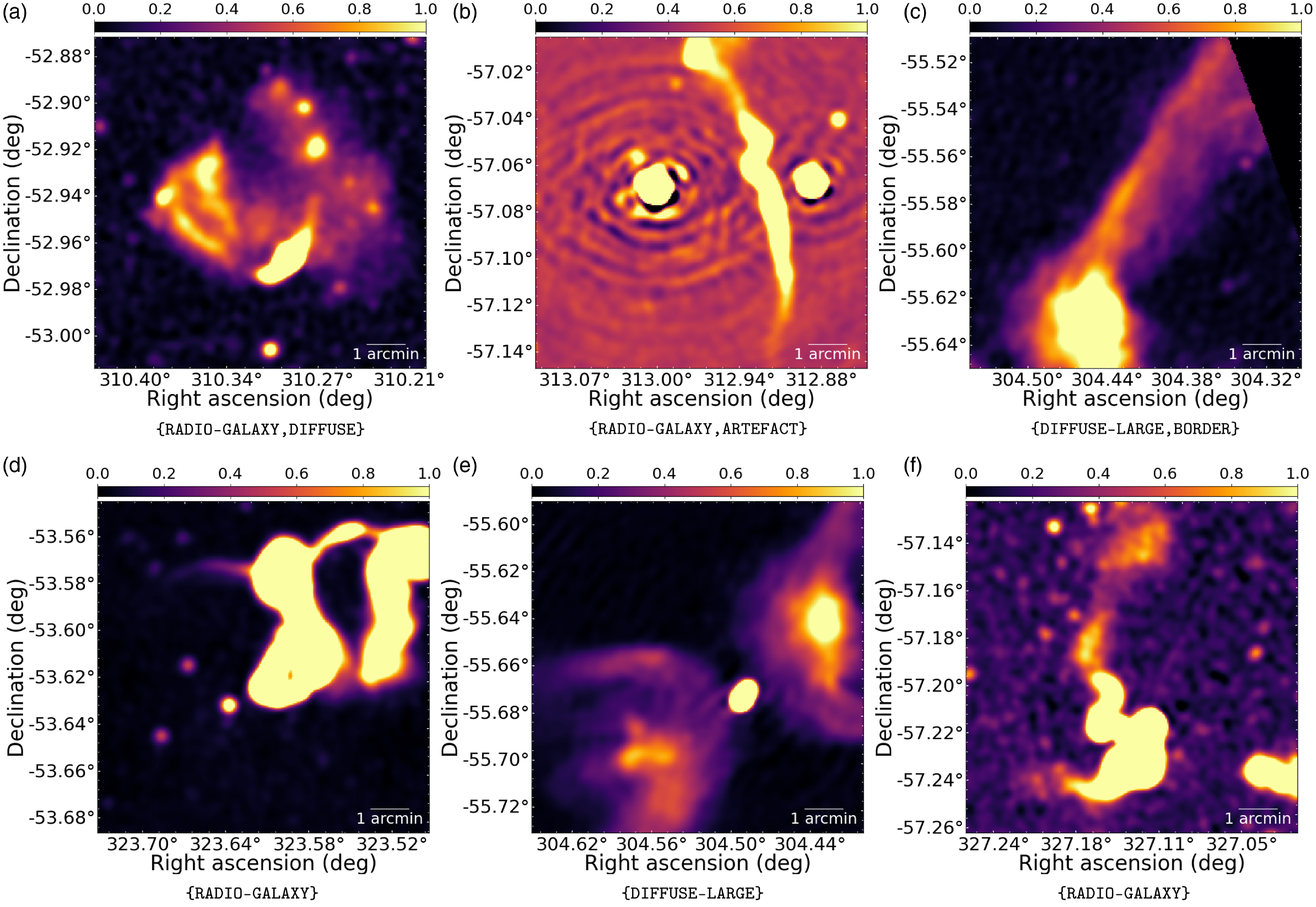
Figure 11. Sample images from the hulk_emupilot dataset, labelled as PECULIAR and COMPACT. The other assigned labels are reported below each frame. A zscale transform was applied to all images for visualization scopes.
In this work, we aim to carry out a blind anomaly search study using a different method, which relies on image features extracted by trained self-supervised models. Details on the dataset used and the methodology are provided in the following paragraphs.
5.1 Dataset
For this analysis, we considered the hulk_emupilot dataset (55,774 images) described in Section 2.2. We annotated through visual inspection approximately 10% of the data (5800 images) using the following set of labels:
-
• BACKGROUND: If the image is purely background noise, e.g. no sources are visible. Typically, this label is set for frames located at the map borders;
-
• COMPACT: if point sources or compact sources comparable with the synthesized beam size (say
 $ \lt $
10 times the beam) are present. Double or triple sources with point-like components also fall into this category;
$ \lt $
10 times the beam) are present. Double or triple sources with point-like components also fall into this category; -
• EXTENDED: if any extended source is visible, e.g. a compact source with extension
 $ \gt $
10
$ \gt $
10
 $\times$
beam;
$\times$
beam; -
• RADIO-GALAXY: if any extended source is visible with a single- or multi-island morphology, suggesting that of a radio galaxy (e.g. core + lobes);
-
• DIFFUSE: if any diffuse source is visible, typically having small-scale (e.g.
 $ \lt $
few arcmin) and roundish morphology;
$ \lt $
few arcmin) and roundish morphology; -
• DIFFUSE-LARGE: if any large-scale (e.g. covering half of the image) diffuse object with irregular shape is visible;
-
• FILAMENT: if any extended filamentary structures is visible;
-
• ARTEFACT: if any ring-shaped or ray-like artefact is visible, e.g. typically around bright resolved sources;
-
• PECULIAR: if any object is found with peculiar/anomalous morphology;
-
• MOSAICKING: if any residual pattern of the mosaicking process used to produce the image is present.
More than one label can be assigned to each image, depending on the object/features the user recognize in the image.
A total of 428 peculiar frames were selected through visual inspection starting from a list of 1198 peculiar frames identified in Segal et al. (Reference Segal2023) with a complexity metric analysis and from a catalogue of 361 peculiar sources reported in Gupta et al. (Reference Gupta2024). In Figure 11 we show examples of peculiar images from the dataset with their annotation labels.
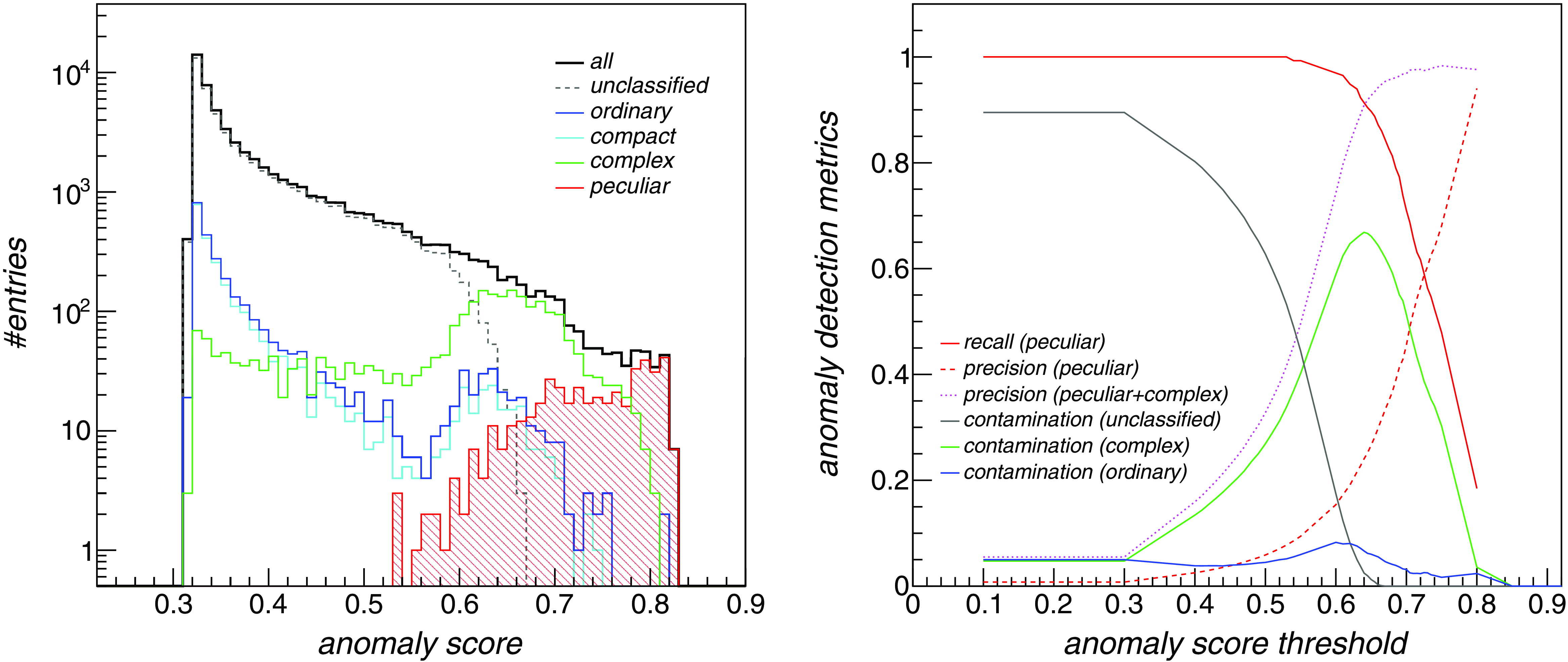
Figure 12. Left: Anomaly score of frames contained in the hulk_emupilot dataset, shown as black solid histogram, found with the Isolation Forest algorithm over top-10 feature data. Unclassified frames are shown with a dashed line. Red filled histogram are the scores of peculiar frames. Ordinary frames (e.g. hosting only compact or artefacts) are shown in blue, pure compact frames in light blue, while frames not tagged as peculiar that host complex sources or structures (EXTENDED, DIFFUSE, DIFFUSE-LARGE, RADIO-GALAXY) are shown in green. Right: Anomaly detection metrics (recall, precision, contamination) as a function of the applied anomaly score threshold. Red solid and dashed lines indicate the recall and precision achieved on peculiar frame detection. Purple dotted line is the precision obtained over both peculiar and complex frames. The other solid coloured lines indicate the fraction of unclassified (black line), complex (green line) and ordinary frames contaminating the selected anomaly sample.
5.2 Anomaly analysis
The data representation variables are each sensitive to different features of the images, including details (e.g. the presence of image borders or artifacts, background noise or mosaicking patterns, compact source density, etc) that are not relevant for the anomaly search task. We tried to limit the dependency on background features with the RandomThresholding augmentation, but the model was not fully made invariant with respect to the other aspects. For this reason, we carried out a feature selection analysis, aiming to explore and select features that are mostly correlated with the presence of objects with diffuse or extended morphology. We divided the labelled set of images into two groups: “interesting” frames include images labelled as {EXTENDED,DIFFUSE,DIFFUSE-LARGE}, while “ordinary” frames include the rest of labelled images, mostly hosting only compact sources or artifacts around them. We then trained a LightGBMFootnote k (Ke et al., Reference Ke2017) classifier to classify the two groups with all representation features (512) as inputs. A subset of available data was reserved as a cross-validation set for model training early stop. Using shallow decision trees (max_depth=2) and default LightGBM parameters (num_leaves=32, min_data_in_leaf=20), we obtained a classification F1-score of 75.3%. In Figure A.2 we report a plot showing the feature importance returned by the LightGBM trained model. As one can see, a small set of features are identified as the most powerful for selecting interesting frames. We therefore carried out the following data exploration and unsupervised analysis, restricting the parameter set to the top-15 ranked variables in importance.
In Figure 3(a) we report a two-dimensional projection of the top-15 variables produced with the UMAP algorithm as a function of the image noise rms level in logarithmic scale (coloured z-axis). As can be seen, the obtained representation shows a residual dependency on physical image parameters, such as the noise rms, that cannot be fully removed by the augmentation scheme currently adopted. In the other panels of Figure A.3 we report the same projection for unlabelled (gray markers) and labelled data, shown with coloured markers. Interestingly, frames that were labelled as peculiar or complex (e.g. containing extended/diffuse objects or artifacts) tend to cluster in specific areas of the projected feature space, also related with higher noise areas, while ordinary frames are uniformly spread in the feature space. Other higher noise areas present in Figure 3(a) seem related to frames that are closer to the mosaic edges or having artifacts (see Figure 3(b)).
We searched for peculiar frames using the Isolation Forest (IF) (Liu et al., Reference Liu2008) outlier detection algorithmFootnote l . We tuned these IF hyperparameters using the annotated dataset:
-
• contamination: The proportion of outliers in the data set. We scanned these values: ‘auto’, 0.001, 0.01, 0.1.
-
• max_samples: The number of samples to draw from the training data to train each base estimator. We scanned these values: ‘auto’, 0.001, 0.01, 0.02, 0.05, 0.1, 0.2, 0.3, 0.4, 0.5, 0.6, 0.7, 0.8, 0.9, 1.0.
Scans were repeated for different choices of importance ranked feature sets: top2, top5, top10, and top15. A number of 200 base estimators were used in the tree ensemble. Other IF parameters were set to defaults. Best classification results were obtained with a smaller fraction of samples (max_samples=0.02) and contamination=0.001.
We then ran the IF algorithm in an unsupervised way with tuned parameters and obtained an anomaly score for each dataset frame. The anomaly score ranges from 0 to 1, with most anomalous data expected to have values close to 1. In Figure 12 (left panel) we report the distribution of IF anomaly scores of all frames contained in the hulk_emupilot dataset, shown as a black solid histogram, found over top-10 feature data. Unclassified frames are shown with a dashed line. The red filled histogram indicates the labelled peculiar frames. Ordinary frames (e.g. hosting only compact or artifacts) are shown in blue, pure compact frames in light blue, while complex frames (e.g. hosting extended or diffuse structures, not labelled as peculiar) are shown in green.
Following Section 2.5, we computed the anomaly detection metrics (peculiar frame recall and precision, non-peculiar frame contamination) as a function of the applied anomaly score threshold. Peculiar frame recall and precision are reported in Figure 12 (right panel) as a function of the applied anomaly score threshold for top-10 feature data, respectively shown with solid and dashed red lines. We also computed the precision in classifying detected frames as either peculiar or complex, shown with a dotted purple line. The other solid coloured lines indicate the fraction of unclassified (black line), complex (green line) and ordinary frames contaminating the selected anomaly sample. In Table 4 we summarized the metrics obtained for different feature sets for the anomaly score threshold that provides the best peculiar recall/precision compromise (e.g. the score at which recall and precision curves cross in Figure 12(b)). Best detection performances (
![]() $\sim$
60%) are obtained with the top-5 features, but the top-10 feature set currently provides the smallest contamination fraction of ordinary frames (
$\sim$
60%) are obtained with the top-5 features, but the top-10 feature set currently provides the smallest contamination fraction of ordinary frames (
![]() $ \lt $
3%). When considering both peculiar and complex frames, the precision increases to 97%.
$ \lt $
3%). When considering both peculiar and complex frames, the precision increases to 97%.
Table 4. Peculiar frame detection metrics obtained with the Isolation Forest algorithm over selected feature sets (column (1)) when using an anomaly score threshold (reported in column (2)) that provides the best compromise in terms of peculiar frame recall and precision, respectively shown in columns (3) and (4). The precision relative to joint peculiar and complex frames is shown in column (5). The fractions of complex and ordinary frames contaminating the predicted anomalous sample are shown in columns (6) and (7).
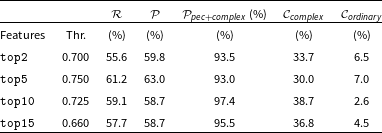
5.3 Astronomer-in-the-loop
It is worth to note that the source peculiarity concept is rather subjective and may depend on the scientific domain of interest. For instance, a fraction of complex frames may well be considered as truly peculiar in specific analysis, and, on the other hand, missed peculiar frames may be considered not as relevant in other contexts. For this reason, an additional “human-in-the-loop” processing stage has to be applied to our list of candidate anomalies to create a refined sample that better fits scientific needs.
For the sake of demonstration, we integrated our dataset in the astronomaly packageFootnote m (Lochner & Bassett, Reference Lochner and Bassett2021). This allowed us to run an active learning process from a web interface in which users can personalize and sort the list of anomalous frames on the basis of the computed score and also their expressed preferences, such as how peculiar a frame is judged on a scale of 1 to 5. A screenshot of the astronomaly UI for our dataset is shown in Figure A.4.
We plan to integrate in the future the full pipeline (feature extraction, anomaly detection, active learning loop) as a supported application within the caesar-rest serviceFootnote n (Riggi Reference Riggi2021), and extend the web UI with missing functionalities (e.g. image filtering/exporting, model importing, configuration options, etc). In this study, we limited ourselves to primarily quantify the ordinary frame rejection power that can be currently achieved with self-supervised features, as this will largely impact the time needed to visually inspect the anomaly candidates in human-in-the-loop approaches to form the final anomaly sample.
6. Summary
In this study, we investigated the potential of self-supervised learning for analysing radio continuum image data produced by SKA precursors. Specifically, we have used the SimCLR contrastive learning framework to train deep network models on large sets of unlabelled images extracted from the ASKAP EMU pilot and SARAO MeerKAT GPS surveys, either randomly selected or centred around catalogued extended source positions. The trained encoder network, based on the ResNet18 architecture, was used as a feature extractor and fine-tuned for three distinct downstream tasks (source detection, morphology classification, and anomaly detection) over test datasets comprising thousands of annotated images from other radio surveys (VLA FIRST, ASKAP Early Science, ATCA Scorpio surveys). Notably, some of these test datasets were purposefully created for this work.
All trained models, including both the source code and network weights, have been publicly released. These represent a first outcome of this work, as they can be viewed as prototypal radio foundational models, available to be used in future applications for multiple scopes:
-
• to extract feature parameters from new radio survey images and perform data inspection, unsupervised classification or outlier detection analysis (as demonstrated in Section 5);
-
• to serve as pre-trained backbone components of more complex models designed for source classification, detection or other tasks (e.g. source property characterization), eventually refined over new labelled datasets (as demonstrated in Sections 3 and 4).
The analyses we performed in this work attempted to address various open questions in this field, paving the way for future analyses:
-
• Do we observe any advantages stemming from self-supervised models trained on easily constructed “random” survey datasets compared to costly-to-compile “source-centric” datasets?
-
• How does self-supervised learning on radio data compare in performance to models pre-trained on extensive non-radio datasets, such as ImageNet?
-
• Is it feasible to enhance existing radio source detectors utilizing deep networks through radio self-supervised pre-training?
We found that using uncurated large collections of unlabelled radio images randomly extracted from SKA precursor surveys resulted in significantly improved performances (approximately 5%) in both radio source detection and classification tasks, compared to curated (albeit smaller) image samples extracted around extended source catalogues. This indication, primarily attributed to the augmented number of accessible images achievable with uncurated collections, is highly encouraging, as it suggests that certain aspects of source analysis can be enhanced even without investing numerous work months in catalogue production.
The advantages gained from self-supervised pre-training on radio data, compared to non-radio data, are notably significant (exceeding 10%) in both source classification and detection tasks. However, when contrasting our findings with fully supervised models trained from scratch, we observed that these benefits are only relevant with small labelled datasets (on the order of a few hundred images). This is certainly a positive aspect, considering that many available annotated datasets (such as MiraBest or similar radio galaxy classification datasets) typically fall within this size range. Nevertheless, in order to observe a substantial impact on larger datasets, it becomes imperative to improve both the self-supervised pre-training dataset and the model itself.
We have identified some areas of developments to be made in the near future to improve source analysis performance, and overcome the limitations encountered in this study. Firstly, we plan to increase the size of our pre-training hulk datasets, by leveraging the massive amount of unlabelled image data being delivered by large area surveys, such as ASKAP EMU, the Very Large Array Sky Survey (VLASS) (Lacy et al., Reference Lacy2020), or the LOFAR Two-metre Sky Survey (LoTSS) (Shimwell et al. Reference Shimwell2017) surveys. In this context, to reduce the computational load during training, it is crucial to explore effective and automated strategies for constructing semi-curated large-scale pre-training datasets, potentially comprising millions of images. This step may require the development of specialized algorithms to filter or weight image frames included in the pre-training dataset, aiming to maximize the balance between ordinary and complex objects “seen” by the model.
Additionally, we have already started to train larger architectures and recent state-of-the-art self-supervised frameworks, particularly those based on Vision Transformers (ViTs), over the same datasets produced for this study. Results will be compared against the SimCLR baseline and presented in a forthcoming paper.
Acknowledgement
This scientific work uses data obtained from Inyarrimanha Ilgari Bundara/the Murchison Radio-astronomy Observatory. We acknowledge the Wajarri Yamaji People as the Traditional Owners and native title holders of the Observatory site. CSIRO’s ASKAP radio telescope is part of the Australia Telescope National Facility (https://ror.org/05qajvd42). Operation of ASKAP is funded by the Australian Government with support from the National Collaborative Research Infrastructure Strategy. ASKAP uses the resources of the Pawsey Supercomputing Research Centre. Establishment of ASKAP, Inyarrimanha Ilgari Bundara, the CSIRO Murchison Radio-astronomy Observatory and the Pawsey Supercomputing Research Centre are initiatives of the Australian Government, with support from the Government of Western Australia and the Science and Industry Endowment Fund.
This work made use of PLEIADI, a computing infrastructure installed and managed by INAF.
Funding statement
This work received funding from the INAF CIRASA and SCIARADA projects.
Competing interests
None.
Data availability statement
The software code used in this work is publicly available under the GNU General Public License v3.0Footnote o on the GitHub repository https://github.com/SKA-INAF/sclassifier/. The trained model weights have been made available on Zenodo repository at https://doi.org/10.5281/zenodo.12636593.
Appendix
A. Supplementary plots

Figure A.1. Examples of sources from the RGZ test dataset that were misclassified by the trained source classifier (hulk_smgps pre-trained and frozen backbone model) due to an incorrect true class label provided in the dataset (mislabelling). The true and predicted class labels are reported below each frame. In many cases, the model indeed correctly predicted the expected true classification (denoted as “true corr.” below each frame).
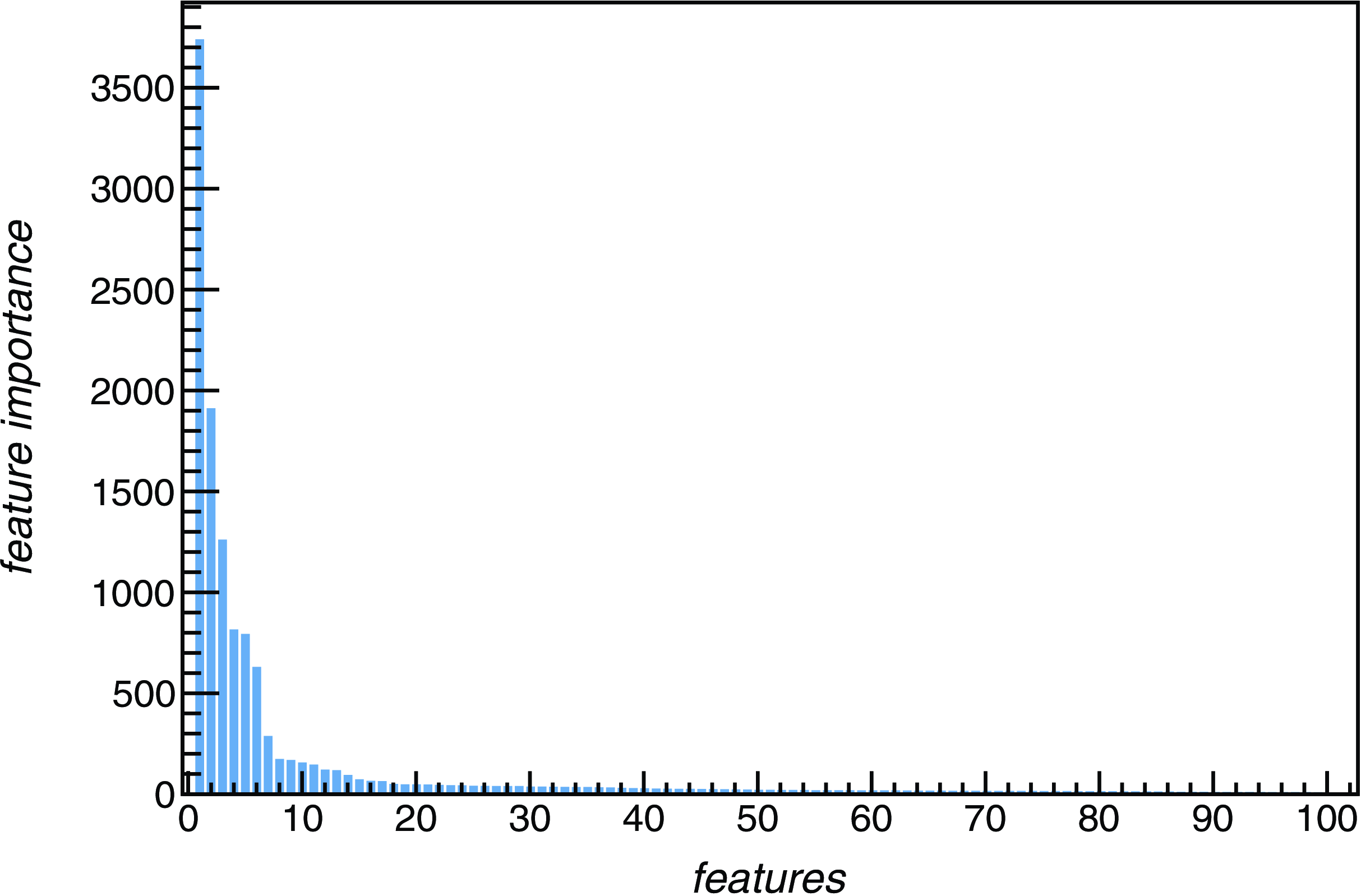
Figure A.2. Feature importance obtained with a LightGBM classifier trained on hulk_emupilot data representation, for the classification of interesting against ordinary images.
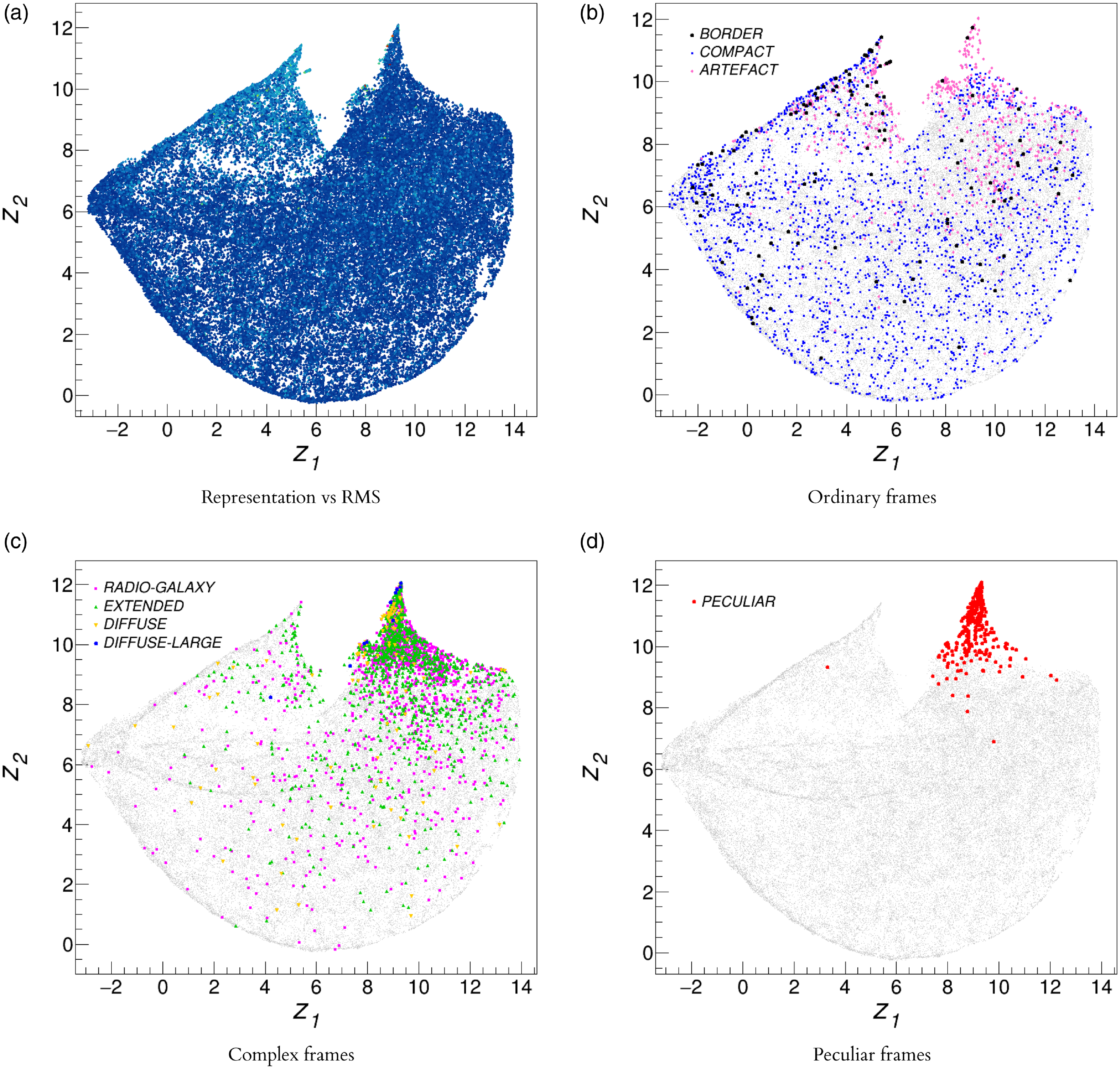
Figure A.3. Figure 14: 2D UMAP projection of the top-15 selected features from the data representation vector produced by the trained SimCLR model on the hulk_emupilot dataset as a function of the image noise RMS level in logarithmic scale (z-scale axis). Red markers correspond to image with higher RMS levels, while blue markers to low noise RMS levels. Left: 2D UMAP projection of the top-15 selected features for unclassified frames (gray markers) and labelled frames (coloured markers, as reported in the plot legends). See text for details on label schema.
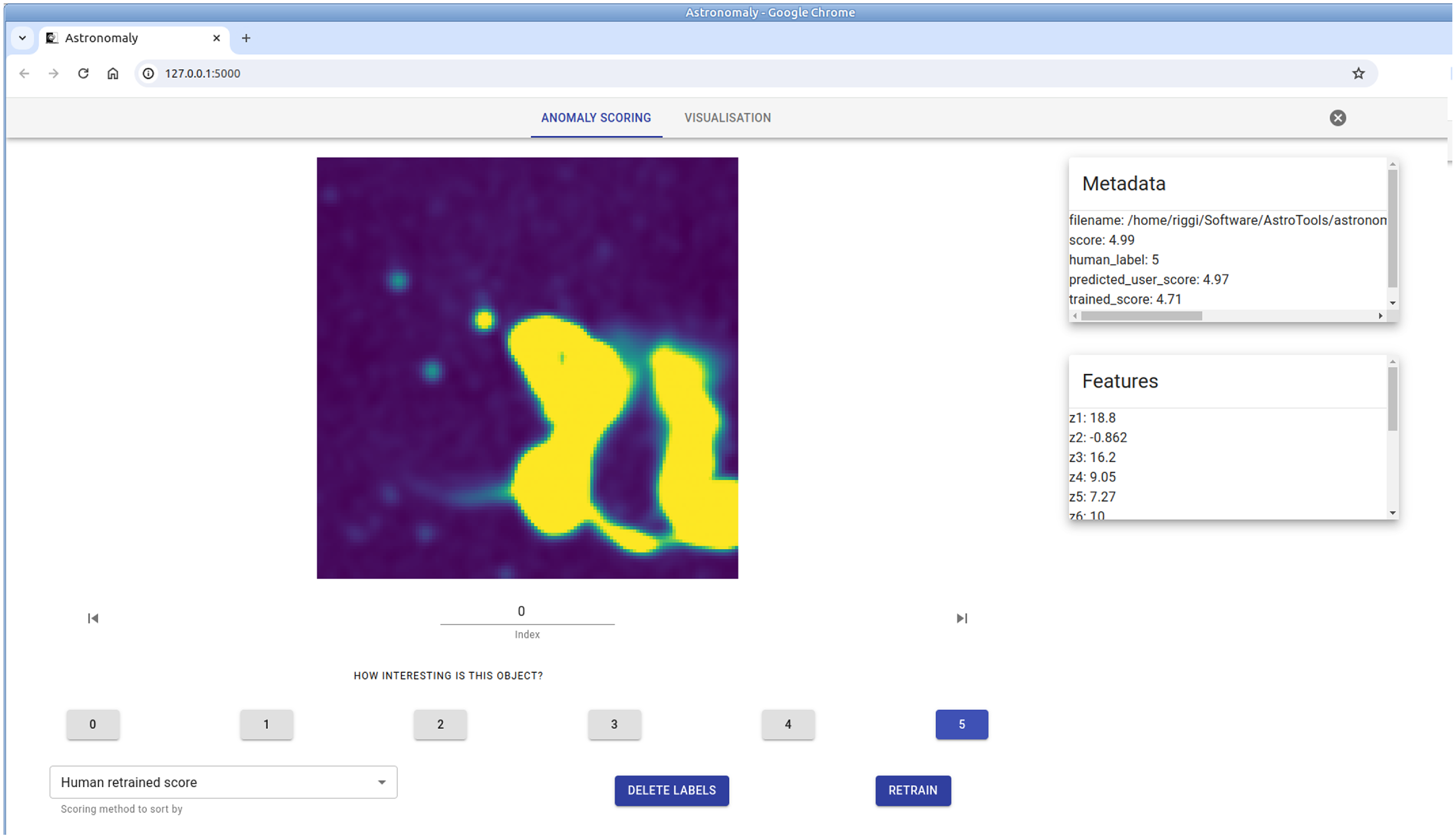
Figure A.4. Screenshot of astronomaly web UI with list of anomalous frames selected from the hulk_emupilot dataset.






























